The Tech Edvocate
- Advertisement
- Home Page Five (No Sidebar)
- Home Page Four
- Home Page Three
- Home Page Two
- Icons [No Sidebar]
- Left Sidbear Page
- Lynch Educational Consulting
- My Speaking Page
- Newsletter Sign Up Confirmation
- Newsletter Unsubscription
- Page Example
- Privacy Policy
- Protected Content
- Request a Product Review
- Shortcodes Examples
- Terms and Conditions
- The Edvocate
- The Tech Edvocate Product Guide
- Write For Us
- Dr. Lynch’s Personal Website
- The Edvocate Podcast
- Assistive Technology
- Child Development Tech
- Early Childhood & K-12 EdTech
- EdTech Futures
- EdTech News
- EdTech Policy & Reform
- EdTech Startups & Businesses
- Higher Education EdTech
- Online Learning & eLearning
- Parent & Family Tech
- Personalized Learning
- Product Reviews
- Tech Edvocate Awards
- School Ratings

Rhyming Capacity: Everything You Need to Know
Phonological awareness: everything you need to know, product review of kate spade’s bloom: the perfect mother’s day gift, learning to read: everything you need to know, product review of the arzopa z1c portable monitor, how to teach phonics: everything you need to know, reading groups: everything you need to know, product review of the ultenic p30 grooming kit, reading anxiety in children: everything you need to know, iep meetings and parent-teacher conferences: everything you need to know, sample timeline for research proposal.

A well-planned research proposal timeline is critical to the success of any project, ensuring that all tasks are completed on time and that the research stays on track. This article outlines a sample timeline for a research proposal, with key milestones and deadlines to help you stay organized and focused.
1.Identify research topic (Week 1)
Start by identifying a suitable research topic that aligns with your academic or professional interests. Make sure the topic is both relevant and unique to instigate curiosity.
2.Conduct a literature review (Weeks 2-4)
Take some time to review existing literature on your chosen topic, including articles, books, reports, and other relevant sources. This will help you get a better understanding of the subject matter and identify gaps in knowledge so that you can formulate your research question.
3.Develop research question (Week 5)
Based on your literature review, develop a specific research question or hypothesis that addresses an identified gap in knowledge. Your research question should be clear, concise, and testable.
4.Write a research proposal (Weeks 6-8)
Write a detailed research proposal that outlines your research question, objectives, methodology, data collection and analysis methods, ethical considerations, timetable, and any other relevant information.
5.Submit proposal for approval (Week 9)
Submit your research proposal to your supervisor or ethics committee (if applicable) for review and approval.
6.Obtain necessary permissions (Week 10)
Before moving forward with your study, ensure to obtain any necessary permissions – such as access to datasets or consent from participants – required for your research.
7.Collect data (Weeks 11-16)
Implement your selected data collection method(s) for gathering relevant information needed to answer your research question.
8.Analyze data (Weeks 17-20)
Analyze the collected data using appropriate statistical or qualitative analysis methods to identify trends, patterns, and insights that can help answer your research question.
9.Write the research report (Weeks 21-24)
Compose a comprehensive research report that synthesizes your findings and presents relevant conclusions and recommendations. The report should include an abstract, introduction, literature review, methodology, results, discussion, conclusion, and references.
10.Revise the research report (Week 25)
Review your initial research report, make any necessary changes based on feedback from your supervisor or peers, and refine it for submission.
11.Submit the final report (Week 26)
Submit your final research report to your supervisor or academic committee for evaluation.
12.Present research findings (Week 27)
Prepare a presentation to share your research findings with your academic community or at conferences. Include an overview of your study’s background, methodology, key findings and their implications.
A well-planned timeline is crucial to the successful completion of a research proposal. This sample timeline can be adjusted as needed based on the requirements of your specific project and institution. Planning ahead with key milestones in mind will enable better organization and time management throughout the research process.
3 Ways to Accept That You Don’t ...
How to measure your windows: 11 steps.
Matthew Lynch
Related articles more from author.

How to Point a Wall: 11 Steps

3 Ways to Fade Acne Scars

4 Ways to Use a Dash in an English Sentence
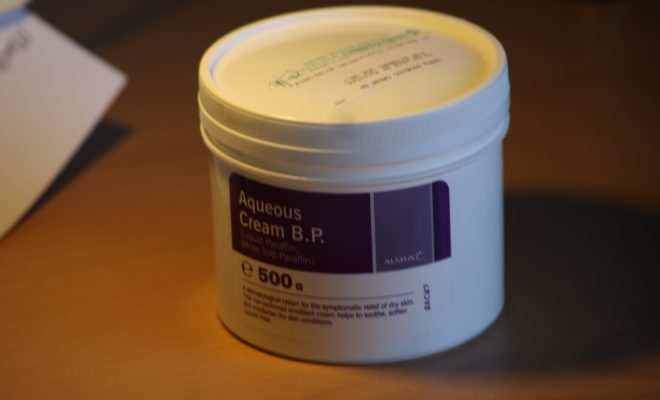
How to Use Aqueous Cream BP

The Best Ways to Kill Ants Using Borax

3 Ways to Avoid Getting Drunk
Research Time Management
- Research time management
- Identify project expectations
- Write a project summary
- Create a project timeline
- Stay motivated
- Get help and support
- Workshop recording
Write a Project Timeline
creating a project timeline .
- Project Timeline Template
Other subtasks
Tests, lab reports, and presentations , for a speech or presentation, consider the following subtasks.
- identifying a topic
- writing talking points
- creating visual aids, including finding images
- transitions
- practice timing the speech
For a lab report, consider the following subtasks
- understanding the experiment
- completing the experiment
- interpret and synthesize results
- research for introductory, support information
- write lab report
- revisions and edits
Studying for a test, consider the following subtasks
- Organize materials and notes
- First review of notes and materials, big picture
- Second review a few days later, to review more challenging concepts
- Third review, a few days later, synthesize
- Fourth review/self test a few days before the test
- Schedule a time to meet with instructor to review concepts you don't understand
- day of pep talk, relax, quick review an hour before the exam.
Strategies for multi-semester projects
Research time management for multi-semester projects.
Strategies for a longer research project are similar to short projects: identify the scope, break the project down into smaller stages, target deadlines.

- << Previous: Write a project summary
- Next: Stay motivated >>
- Last Updated: Oct 23, 2023 12:13 PM
- URL: https://libguides.wmich.edu/timemanagement
- Link to facebook
- Link to linkedin
- Link to twitter
- Link to youtube
- Writing Tips
How to Create a Research Timeline for Your Thesis

5-minute read
- 21st May 2023
Beginning a dissertation can feel both thrilling and overwhelming. One of the best things you can do to prepare for the exciting journey of doing a dissertation is to design a comprehensive timeline as your guide. Here we will take you step by step through creating your thesis timeline and provide some example templates, so you’ll be well-prepared to begin your dissertation work.
Reasons for Creating a Timeline
There are many benefits to crafting a detailed dissertation timeline. In addition to helping with time management and meeting crucial deadlines, your timeline will also help you stay motivated by reviewing the tasks you have completed as you progress. A thorough timeline will be valuable during your dissertation proposal and useful if you are applying for grants or other additional funding.
Ste0ps for Creating a Timeline for Your Thesis:
- Research and record all requirements and deadlines.
Before you write out your timeline, ensure you know all of your program’s requirements and deadlines. Academic institutions often require you to complete your dissertation within a specified timeframe.
There are likely several recommended or mandatory deadlines for approval of certain items by your adviser (and possibly the rest of your committee members). Gather all these dates beforehand so you can allot an appropriate amount of time to meet your deadlines.
It will be beneficial to meet with your adviser to understand when you are expected to complete the major phases of your dissertation work and to confirm that there aren’t any other requirements or deadlines that you may not be aware of.
- List all of your tasks and bundle them into phases.
Now that you’ve assembled your dates, working backward from your deadlines is a good rule of thumb. List all of the required tasks that must be completed to meet each milestone, from coming up with your research questions to writing each chapter of your dissertation .
Even though your list will be unique to your research project, it can help to refer to a thesis checklist . It’s also helpful to assemble tasks into different phases (e.g., dissertation proposal, research recruitment). Grouping tasks into phases gives anyone looking at your timeline a quick overview of your research plan.
- Organize your tasks into a schedule and assign task deadlines.
Now it’s time to build your timeline. There are many different free templates available online, from straightforward lists of deliverables to colorful options with room for notes and customization.
Find this useful?
Subscribe to our newsletter and get writing tips from our editors straight to your inbox.
A popular organizational approach for thesis timelines is a Gantt chart , which is a type of bar chart often used in project management in which the length of the bar corresponds to the time the task will take. The best choice for you will depend on the specifics of your research study and personal preferences. Whichever option you select, make sure you can easily edit and revise it as need be.
Sanity-Saving Tips:
● Pay attention to your work style. Some people are more productive when writing in short bursts, while others write better after taking time to get into the zone. Some people choose to start writing parts of their thesis while still conducting research, while others prefer to focus on one phase at a time. Set yourself up for success by reflecting on what type of schedule will help you create the best quality work.
● Schedule breaks. Almost everyone will work better after a well-deserved break. Make sure to schedule regular breaks into your timeline, as well as provide enough time to sleep, eat well, and do anything else you need to do to safeguard your well-being.
● Always have a plan B. Your dissertation is an extensive endeavor with many moving parts. It’s impossible to anticipate and plan for every conceivable event, but it’s helpful to expect something may occur that will cause a deviation from your original timeline. Perhaps study recruitment takes longer than you expected, or one of your committee members gets sick and you have to postpone your dissertation proposal. After you draft your timeline, check that it is not so strict that any disruption will cause a total derailment of your plan. Aim to strike a balance between goals that will inspire you to progress steadfastly and have some leeway in your timeline for the inevitable curveball that life will throw at you somewhere along the way.
Following these three steps will help you draft a timeline to steer the course of your dissertation work: research and record all requirements and deadlines; work backward from your dissertation deadline and assemble your task lists; and organize your tasks into a timeline.
Don’t forget to include ample time for editing and proofreading your dissertation . And if you are interested in any help from us, you can try a sample of our services for free . Best of luck in writing your dissertation!
Share this article:
Post A New Comment
Got content that needs a quick turnaround? Let us polish your work. Explore our editorial business services.
3-minute read
How to Insert a Text Box in a Google Doc
Google Docs is a powerful collaborative tool, and mastering its features can significantly enhance your...
2-minute read
How to Cite the CDC in APA
If you’re writing about health issues, you might need to reference the Centers for Disease...
Six Product Description Generator Tools for Your Product Copy
Introduction If you’re involved with ecommerce, you’re likely familiar with the often painstaking process of...
What Is a Content Editor?
Are you interested in learning more about the role of a content editor and the...
4-minute read
The Benefits of Using an Online Proofreading Service
Proofreading is important to ensure your writing is clear and concise for your readers. Whether...
6 Online AI Presentation Maker Tools
Creating presentations can be time-consuming and frustrating. Trying to construct a visually appealing and informative...

Make sure your writing is the best it can be with our expert English proofreading and editing.
Our websites may use cookies to personalize and enhance your experience. By continuing without changing your cookie settings, you agree to this collection. For more information, please see our University Websites Privacy Notice .
Office of Undergraduate Research
Surf awards: sample timelines.
- Program Information
- Prepare Your Application
- Budget Policies & Samples
- Sample Timelines
Your SURF proposal timeline should:
- clearly indicate start and end dates,
- include an anticipated number of project work hours each week (maximum: 40),
- include a total number of project work hours,
- provide a week-by-week listing of planned project milestones, and
- include your full name.
This level of detail will show the reviewers you have carefully structured your project. Account for your planned enrollment in summer coursework, participation in study abroad programs, and/or any other substantial commitments in your timeline. All weeks of summer research must be completed between May 6 and August 23, 2024 .
The standard SURF timeline involves working on your project 40 hours/week for 9 weeks (or 35 hours/week for 10 weeks). However, the weeks need not be continuous, and you might elect to work fewer hours per week if that would be more appropriate to your particular situation. If you commit to fewer than 350 total project hours, your stipend amount will be prorated.
There are many different ways to present a timeline; three good examples follow below. Remember that your proposal, timeline, and budget should work in concert to demonstrate the feasibility of your project.
Timeline – Jane Husky Total project hours – 350. Work week: Mon-Fri, 9am-5pm (35 hrs/week for 10 weeks). I will have weekly lab meetings with my advisor to track progress and troubleshoot any major issues. I will also be consulting regularly with graduate students in the lab working on related projects.
Timeline – Jonathan Husky Work weeks will be 5 days per week (Mon. – Fri.) at an average of 25 hours per week, totaling approximately 400 hours. In accordance with the policies of the Institute of Materials Science, I will not be working in the lab in the absence of supervision from either a graduate student or instructor.
Timeline – June Husky
I will remain in regular touch with my advisor, Professor Cross, throughout the summer. We have scheduled weekly Skype calls for the time I will be in Brazil and biweekly meetings on campus upon my return. Project hours: 350 hours total.
How to Write a Timeline for a Research Proposal
Harrison pennybaker.

Developing a proper timeline for your research proposal is essential for the process. Writing a research proposal might seem like a daunting and, at times, unending process. However, like any large project, breaking the task down into smaller, more manageable tasks makes the job easier and far less stressful. A timeline can help you plan these tasks. Once you have made basic preparations for your proposal, write your timeline.
Familiarize yourself with the requirements, rules, and procedures of the body or individual for whom you are writing the timeline. If you are writing the plan for yourself, then you set your own parameters; however, if you are writing your research proposal for a granting agency, professor, superior, or institution, then you'll need to be familiar with their requirements, including any relevant deadlines. Take these into account before preparing your timeline. Check if deadlines, requirements, and other formalities are negotiable or flexible.
Determine the total amount of time that you will be carrying out and writing up your research, as well as any specific deadlines that you'll need to meet. This is important for determining the start point and end point of your timeline. Make realistic estimates, and, when in doubt, opt for a longer timeline rather than a shorter one if possible. It's usually better to propose a longer timeline and then come in early than it is to propose a shorter one and come in late.
Determine how many phases, steps, or tasks your project will require, name them, and break them into sub-components, if applicable. Depending on your project, you may have several distinct sections, and these sections may include their own sub-sections. Determining the sections and breaking them into smaller components will allow you to develop a more precise and detailed idea of how much time you will require. It will also help you develop a better working plan, because time management is easier when you know exactly what you are required to do.
Break your phases, steps, or tasks down into time increments appropriate for the length of the project. For instance, if your project involves only four phases and will take two years, break down the steps for your project into monthly increments; for instance, allow six months for research, six months for processing and sorting data, six months for writing the piece, and six months for edits and printing.
Review your timeline as your project unfolds, and, if possible, amend it as required. A timeline is an estimate and plan for the unfolding of a project, but it's useful to keep an eye on it as you progress. Individual deadlines will vary in terms of flexibility, so your timeline management will also vary. Try not to rush just to meet your pre-set timeline if that will sacrifice the quality of your work. Adjust the timeline if necessary.
- 1 Northwest Arkansas Community College: Proposal Development Timeline
About the Author
Harrison Pennybaker began writing in 2004. He has written as a student and a journalist, specializing in politics, travel, arts and culture and current affairs. He holds a Master of Arts in political science and is currently pursuing a Doctor of Philosophy in political science.
Related Articles

How to Make a Timeline for an Essay

How to Plan a School Project

How to Write a Timetable for a Dissertation

Allocating Time to Write an Essay

Examples of Short- and Long-Term Writing Goals

How to Write an Outline for a School Project

Two Kinds of Commitment in a Relationship

How to Write a Timeline for a Qualitative Research...

How to Make a Linear Timeline

How to Write a Process Analysis Essay

Work Plan for Ph.D. Research

How to Write a Research Design

How to Write a Peace Agreement

How to Write a Thesis Rough Draft

How to Study for Multiple Midterms in College

How to Deal With a Friend Who Just Ended a Long Relationship

How to Make a Roman Numeral Outline

How Did Pyramids Affect People's Lives in Ancient Egypt?

How to Write a Project System Overview

How to Get a Ph.D. in Immunology
Regardless of how old we are, we never stop learning. Classroom is the educational resource for people of all ages. Whether you’re studying times tables or applying to college, Classroom has the answers.
- Accessibility
- Terms of Use
- Privacy Policy
- Copyright Policy
- Manage Preferences
© 2020 Leaf Group Ltd. / Leaf Group Media, All Rights Reserved. Based on the Word Net lexical database for the English Language. See disclaimer .
Research Proposal Example/Sample
Detailed Walkthrough + Free Proposal Template
If you’re getting started crafting your research proposal and are looking for a few examples of research proposals , you’ve come to the right place.
In this video, we walk you through two successful (approved) research proposals , one for a Master’s-level project, and one for a PhD-level dissertation. We also start off by unpacking our free research proposal template and discussing the four core sections of a research proposal, so that you have a clear understanding of the basics before diving into the actual proposals.
- Research proposal example/sample – Master’s-level (PDF/Word)
- Research proposal example/sample – PhD-level (PDF/Word)
- Proposal template (Fully editable)
If you’re working on a research proposal for a dissertation or thesis, you may also find the following useful:
- Research Proposal Bootcamp : Learn how to write a research proposal as efficiently and effectively as possible
- 1:1 Proposal Coaching : Get hands-on help with your research proposal

FAQ: Research Proposal Example
Research proposal example: frequently asked questions, are the sample proposals real.
Yes. The proposals are real and were approved by the respective universities.
Can I copy one of these proposals for my own research?
As we discuss in the video, every research proposal will be slightly different, depending on the university’s unique requirements, as well as the nature of the research itself. Therefore, you’ll need to tailor your research proposal to suit your specific context.
You can learn more about the basics of writing a research proposal here .
How do I get the research proposal template?
You can access our free proposal template here .
Is the proposal template really free?
Yes. There is no cost for the proposal template and you are free to use it as a foundation for your research proposal.
Where can I learn more about proposal writing?
For self-directed learners, our Research Proposal Bootcamp is a great starting point.
For students that want hands-on guidance, our private coaching service is recommended.

Psst… there’s more!
This post is an extract from our bestselling short course, Research Proposal Bootcamp . If you want to work smart, you don't want to miss this .
You Might Also Like:

10 Comments
I am at the stage of writing my thesis proposal for a PhD in Management at Altantic International University. I checked on the coaching services, but it indicates that it’s not available in my area. I am in South Sudan. My proposed topic is: “Leadership Behavior in Local Government Governance Ecosystem and Service Delivery Effectiveness in Post Conflict Districts of Northern Uganda”. I will appreciate your guidance and support
GRADCOCH is very grateful motivated and helpful for all students etc. it is very accorporated and provide easy access way strongly agree from GRADCOCH.
Proposal research departemet management
I am at the stage of writing my thesis proposal for a masters in Analysis of w heat commercialisation by small holders householdrs at Hawassa International University. I will appreciate your guidance and support
please provide a attractive proposal about foreign universities .It would be your highness.
comparative constitutional law
Kindly guide me through writing a good proposal on the thesis topic; Impact of Artificial Intelligence on Financial Inclusion in Nigeria. Thank you
Kindly help me write a research proposal on the topic of impacts of artisanal gold panning on the environment
I am in the process of research proposal for my Master of Art with a topic : “factors influence on first-year students’s academic adjustment”. I am absorbing in GRADCOACH and interested in such proposal sample. However, it is great for me to learn and seeking for more new updated proposal framework from GRADCAOCH.
Submit a Comment Cancel reply
Your email address will not be published. Required fields are marked *
Save my name, email, and website in this browser for the next time I comment.
- Print Friendly

- Code of Ethics
- Dissertation Editing
- Dissertation Coaching
- Free Consultation
How to Create a Dissertation Timeline (With Examples + Tempate)
When it’s time to start thinking about writing your dissertation, it is vital to put together a dissertation timeline. This will help you map out the months you will be spending on your dissertation, and ensure that you’re staying on track. A specific and detailed dissertation timeline will serve as an outline to guide you, step by step, through what can be a long and challenging process.
While we often refer to a dissertation in a way that makes it sound like a monolith, in reality, a dissertation consists of many moving parts. A dissertation timeline includes a series of milestones that leads up to the dissertation defense , revisions, and final submission of your dissertation. Constructing an outline of every step in the dissertation process , including rough estimates of how long each will take, will give you a realistic picture of where you are in the process at any given time.
Before embarking on your dissertation, it is a good idea to meet with your dissertation advisor and sketch out a dissertation timeline that is realistic for the size and scope of your project and includes deadlines. This will provide you with much-needed structure and a sense of what will happen next. To get an idea of what a completed dissertation looks like and the components your program requires, ask to see samples from recent graduates in your department.
These are a few frequently asked questions about crafting a dissertation timeline:
- What does a dissertation timeline look like?
- What goes in a dissertation timeline?
- How structured should a dissertation timeline be?
- What do you do with a dissertation timeline?

What Does a Dissertation Timeline Look Like?
One way to think about a dissertation timeline is as a kind of outline. While the outlining process is unique to each writer, there are commonalities shared by all of them. Likewise, when writing a dissertation timeline, you’ll want to include all of the basic elements of your dissertation as well as the amount of time you think you’ll need to execute them.
The best dissertation timeline format is the one that works for you. Though I’ve reformed somewhat over the years, for a long time I wasn’t a fan of intensely detailed outlines. Many people don’t like outlines. And that’s okay! However, writing a dissertation is not the time to be flying by the seat of your pants. To get started, a simple, linear timeline that projects the amount of time you think you’ll need to write your dissertation will suffice.
Example Dissertation Timeline
Below, you’ll find an example of a dissertation timeline, which you can view as an image in your browser or download as a spreadsheet. Feel free to use the spreadsheet as a template as you build your own dissertation timeline.
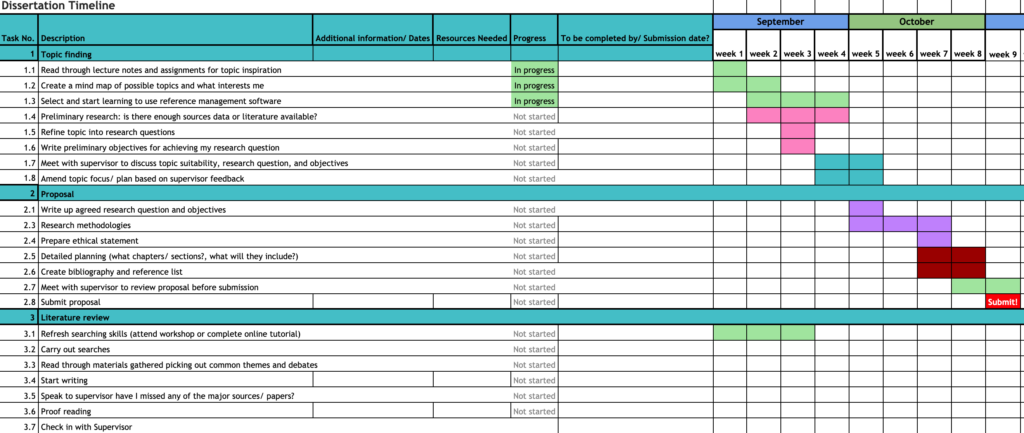
Or download the spreadsheet below:
Inclusion in a Dissertation Timeline
When constructing your dissertation timeline, include every element of the dissertation from the abstract to the conclusion. Keep in mind that you may not be writing your chapters in chronological order. For instance, after completing their first round of research and writing their research question, most graduate students will tackle their literature review next, even though it comes after the abstract and introduction in the final document.
Depending on the field being studied, most dissertations will also include sections for methodology, results, and discussion. Many programs also require a detailed conclusion that alludes to future research possibilities. Every dissertation also has an extensive list of references (pro tip: write this as you’re writing your dissertation), as well as appendices for charts, graphs, and other ephemera. And don’t forget your acknowledgments!
Dissertation Timeline Structure
The structure of your dissertation timeline will take shape once you’re engaged in the research process. While a road map may seem like an apt metaphor for a dissertation, once you get started you may notice a lot of starts and stops and circling back. After you’ve begun researching, you may realize that you need to allot more time for digging through the databases, or you may discover that you need to reformulate your research question entirely.

I’ve seen many of my own graduate students use calendars to great effect, giving themselves hard and fast deadlines to meet. Many students also build out their dissertation timelines as they progress, attaching working drafts of their abstract, introduction, and literature review to their timeline within a giant spreadsheet that links to multiple documents and sources. All of these methods are valid. Devise one that works for you.
Using a Dissertation Timeline
So once you have a thoughtful, soundly-constructed dissertation timeline, what do you do with it? First, and most importantly, try your best to adhere to it. Check in with your dissertation timeline regularly, and use it to keep yourself on track. Also, make adjustments to it as needed. If you find yourself breezing through your preliminary research but needing a bit more time for your literature review, consult your timeline and adjust accordingly.
While meeting your deadlines is important, also construct your dissertation timeline with an understanding that many graduate students face delays once they start working on their dissertation. These can include hold-ups at the department or university level in the form of late IRB approval or limited lab space or grant funding that gets cut. Anything can happen, but having a dissertation timeline will help you get back on track as soon as the storm passes.
In my own experience, I also found my dissertation timeline to be a great document to share and discuss with my dissertation chair and committee. Once I finished my comprehensive exams, I met with members of my dissertation committee and got feedback on my rough dissertation timeline to make sure my goals for submitting my dissertation and graduating were realistic. This also ensured that we were all on the same page.
When writing a dissertation, timing is everything. Creating a dissertation timeline gives you definitive time limits for research and writing, and it also influences several other major decisions that you’ll need to make. These include preparation to go on the job market, which often coincides with writing your dissertation. There is no doubt that this will be a hectic time in your graduate school career, but having a well-organized dissertation timeline is a good way to keep everything in perspective.
Related posts:

Courtney Watson, Ph.D.
Courtney Watson, Ph.D. is an Associate Professor of English at Radford University Carilion, in Roanoke, Virginia. Her areas of expertise include undergraduate and graduate curriculum development for writing courses in the health sciences and American literature with a focus on literary travel, tourism, and heritage economies. Her writing and academic scholarship has been widely published in places that include Studies in American Culture , Dialogue , and The Virginia Quarterly Review . Her research on the integration of humanities into STEM education will be published by Routledge in an upcoming collection. Dr. Watson has also been nominated by the State Council for Higher Education of Virginia’s Outstanding Faculty Rising Star Award, and she is a past winner of the National Society of Arts & Letters Regional Short Story Prize, as well as institutional awards for scholarly research and excellence in teaching. Throughout her career in higher education, Dr. Watson has served in faculty governance and administration as a frequent committee chair and program chair. As a higher education consultant, she has served as a subject matter expert, an evaluator, and a contributor to white papers exploring program development, enrollment research, and educational mergers and acquisitions.
Comments are closed.
How to Finish Your Dissertation in Half the Time
Learn how to avoid the pitfalls preventing you from finishing your dissertation faster.

Subscribe to get the free eBook!
Dr. Courtney Watson In the News
“ See It for Yourself ” in With Good Reason: Beyond the Book July 22, 2022
“ I Thought You’d Never Ask: Consent in Contemporary Romance ” in New Frontiers in Popular Romance (McFarland) June 13, 2022
- Common Errors
- Dissertation Success
- Presentation
- Quantitative Analysis
- Surviving Grad School
“How to Finish Your Dissertation in Half the Time”

Proposal Timelines
Two kinds of time lines need to be considered in a proposal: Internal and External.
INTERNAL TIME LINE
The Internal time line describes the schedule of events/activities that will be conducted if the project or program that the proposal is funded (presented as a “calendar” with “milestones”). This should be linked to the funding requested, which is presented in the proposal budget, to demonstrate how funds will used at the various stages of the project/program and linked to the personnel who will be responsible for each step or activity in the proposed project/program.
EXTERNAL TIME LINE
The External time line relates to when funding is needed to conduct the project/program. It is important to know submission deadlines, review cycles, and funding calendars of corporations and foundations to which a Letter of Inquiry or a Proposal will be sent – and understand how this will affect the development or implementation of a project or program.
You are likely to be disappointed if do not begin the funding request process until May when you need funding for September.
Suggested Timeline for Submitting Grant Proposals
Plan your timeline by working backwards from the submission due date. For example, if your grant or fellowship proposal is due September 15, plan to get started by no later than June. Remember that the first step in grantseeking is not to sit down and write, but simply to read carefully through the grant guidelines. Below are a series of small steps that can help you more easily fit grantseeking into your busy schedule.
3-6 months before deadline
- Read guidelines; contact your Grant Coordinator for assistance.
- If proposal involves cost-sharing, contact your department chair and the Dean.
- If your project will involve human subjects, vertebrate animals, or the other compliance issues, get in touch with Research Integrity .
2 months before deadline
- Start your proposal in the Cloud Express system.
- Draft concept paper and develop timeline for your grant-funded project.
- Begin preparing your budget with the assistance of your Grant Coordinator .
- Contact organizations or colleagues for letters of support.
1 month before
- Draft proposal and share it with colleagues for feedback.
- Send the Grant Coordinator your budget draft.
Two weeks before
- Incorporate draft and budget feedback.
- Complete proposal documents and budget, submit to your Grant Coordinator .
- Upon completion of review, the grant coordinator will submit the proposal to automatically collect signatures from your department chair, the Dean, and other approvers as needed. These approvals are required before you submit any proposal for an award that will be administered through the university.
Examples of submission deadlines and review cycles
In general, the process of developing a funding request should begin 12 to 18 months before the grant is needed .
This will vary if there is a one-step process – submitting a proposal is the only step – or a two-step process (sending a Letter of Inquiry seeking an invitation to submit a proposal, then developing and presenting a full Proposal if invited).
Example for large funding program
For funders with no deadlines for submission..
In some cases, funders note that applications are accepted at any time. However, it is probable that there will be a period of at least three to six months before the application is reviewed by a corporate contributions committee or a foundation board of directors and a decision about providing funding is made.
Also note that the result of the initial review may then be to invite the applicant to submit a full funding request, which in turn may not be reviewed for three to six months before the final decision is reached on whether to provide funding or not.
Even in this case, the process of developing a funding request should begin 9 to 12 months before the grant is needed.
Last updated: 4/23/2021
- Impact Areas
- About Research Development
- Funding Opportunities
- Professional Development
- Intellectual Property
- About Proposal Preparation and Submission
- Initiate Proposal
- Prepare Proposal
- Submit Proposal
- Research Integrity
- About Award Management
- Award Setup
- Ongoing Award Management
- Award Closeout
- Award Management FAQs
- Award Management Forms
- About the Research Support Library
- About the Office of Research
- GS University Policies
- Uniform Guidance
- Federal Agency Updates
- Research Admin SOP Manual
- Research Admin Resources
- Student Research & Creative Activity
- Research Symposium
- Contact the Office of Research
- Participant Support Costs
- Diversity, Equity and Inclusion Resources
- Research Advocates
Georgia Southern University Research Services
Office of Research • P.O. Box 8005, Statesboro, GA 30460-8005 • 912-478-5465 • [email protected]
Planning your PhD research: A 3-year PhD timeline example
Planning out a PhD trajectory can be overwhelming. Example PhD timelines can make the task easier and inspire. The following PhD timeline example describes the process and milestones of completing a PhD within 3 years.
Elements to include in a 3-year PhD timeline
The example scenario: completing a phd in 3 years, example: planning year 1 of a 3-year phd, example: planning year 2 of a 3-year phd, example: planning year 3 of a 3-year phd, example of a 3 year phd gantt chart timeline, final reflection.
Every successful PhD project begins with a proper plan. Even if there is a high chance that not everything will work out as planned. Having a well-established timeline will keep your work on track.
What to include in a 3-year PhD timeline depends on the unique characteristics of a PhD project, specific university requirements, agreements with the supervisor/s and the PhD student’s career ambitions.
For instance, some PhD students write a monograph while others complete a PhD based on several journal publications. Both monographs and cumulative dissertations have advantages and disadvantages , and not all universities allow both formats. The thesis type influences the PhD timeline.
Furthermore, PhD students ideally engage in several different activities throughout a PhD trajectory, which link to their career objectives. Regardless of whether they want to pursue a career within or outside of academia. PhD students should create an all-round profile to increase their future chances in the labour market. Think, for example, of activities such as organising a seminar, engaging in public outreach or showcasing leadership in a small grant application.
The most common elements included in a 3-year PhD timeline are the following:
- Data collection (fieldwork, experiments, etc.)
- Data analysis
- Writing of different chapters, or a plan for journal publication
- Conferences
- Additional activities
The whole process is described in more detail in my post on how to develop an awesome PhD timeline step-by-step .
Many (starting) PhD students look for examples of how to plan a PhD in 3 years. Therefore, let’s look at an example scenario of a fictional PhD student. Let’s call her Maria.
Maria is doing a PhD in Social Sciences at a university where it is customary to write a cumulative dissertation, meaning a PhD thesis based on journal publications. Maria’s university regulations require her to write four articles as part of her PhD. In order to graduate, one article has to be published in an international peer-reviewed journal. The other three have to be submitted.
Furthermore, Maria’s cumulative dissertation needs an introduction and conclusion chapter which frame the four individual journal articles, which form the thesis chapters.
In order to complete her PhD programme, Maria also needs to complete coursework and earn 15 credits, or ECTS in her case.
Maria likes the idea of doing a postdoc after her graduation. However, she is aware that the academic job market is tough and therefore wants to keep her options open. She could, for instance, imagine to work for a community or non-profit organisation. Therefore, she wants to place emphasis on collaborating with a community organisation during her PhD.
You may also like: Creating awesome Gantt charts for your PhD timeline
Most PhD students start their first year with a rough idea, but not a well-worked out plan and timeline. Therefore, they usually begin with working on a more elaborate research proposal in the first months of their PhD. This is also the case for our example PhD student Maria.
- Months 1-4: Maria works on a detailed research proposal, defines her research methodology and breaks down her thesis into concrete tasks.
- Month 5 : Maria follows a short intensive course in academic writing to improve her writing skills.
- Months 5-10: Maria works on her first journal paper, which is based on an extensive literature review of her research topic. At the end of Month 10, she submits the manuscript. At the same time, she follows a course connected to her research topic.
- Months 11-12: Maria does her data collection.
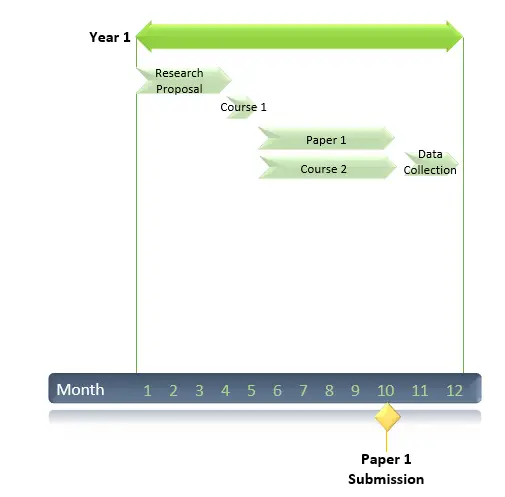
Maria completed her first round of data collection according to plan, and starts the second year of her PhD with a lot of material. In her second year, she will focus on turning this data into two journal articles.
- Months 1-2: Maria works on her data analysis.
- Months 3-7: Maria works on her second journal paper.
- Month 7: Maria attends her first conference, and presents the results of her literature-review paper.
- Month 8: Maria received ‘major revisions’ on her first manuscript submission, and implements the changes in Month 8 before resubmitting her first journal paper for publication.
- Month 9: Maria follows a course on research valorisation to learn strategies to increase the societal impact of her thesis.
- Months 9-12: Maria works on her third journal paper. She uses the same data that she collected for the previous paper, which is why she is able to complete the third manuscript a bit faster than the previous one.
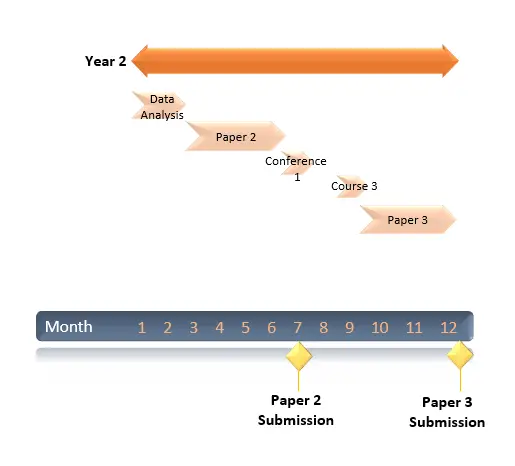
Time flies, and Maria finds herself in the last year of her PhD. There is still a lot of work to be done, but she sticks to the plan and does her best to complete her PhD.
- Month 1: Maria starts a second round of data collection, this time in collaboration with a community organisation. Together, they develop and host several focus groups with Maria’s target audience.
- Month 2: Maria starts to analyse the material of the focus group and develops the argumentation for her fourth journal paper.
- Month 3: Maria presents the results of her second journal paper at an international conference. Furthermore, she helps out her supervisor with a grant application. They apply for funding to run a small project that is thematically connected to her PhD.
- Months 4-9: Maria writes her fourth and final journal article that is required for her PhD.
- Month 10: Maria writes her thesis introduction .
- Month 11: Maria works on her thesis conclusion.
- Month 12 : Maria works on the final edits and proof-reading of her thesis before submitting it.
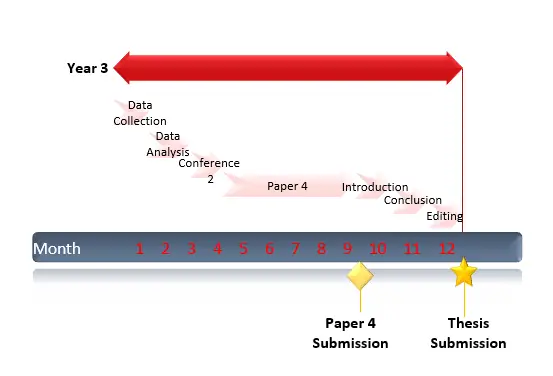
Combining the 3-year planning for our example PhD student Maria, it results in the following PhD timeline:
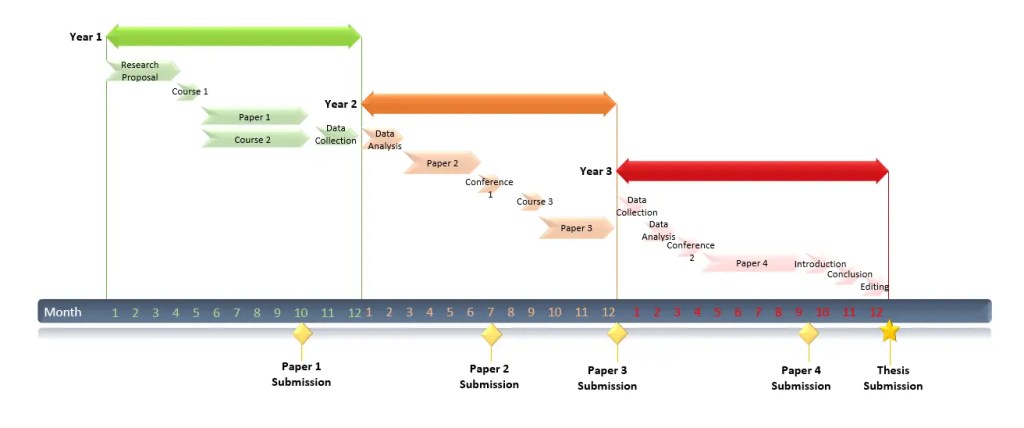
Creating these PhD timelines, also called Gantt charts, is easy. You can find instructions and templates here.
Completing a PhD in 3 years is not an easy task. The example of our fictional PhD student Maria shows how packed her timeline is, and how little time there is for things to go wrong.
In fact, in real life, many PhD students spend four years full-time to complete a PhD based on four papers, instead of three. Some extend their studies even longer.
Furthermore, plan in some time for thesis editing, which is a legitimate practice and can bring your writing to the next level. Finding a reputable thesis editor can be challenging, so make sure you make an informed choice.
Finishing a PhD in 3 years is not impossible, but it surely is not easy. So be kind to yourself if things don’t work out entirely as planned, and make use of all the help you can get.
Get new content delivered directly to your inbox!
Subscribe and receive Master Academia's quarterly newsletter.
10 amazing benefits of getting a PhD later in life
How to prepare your viva opening speech, related articles.

Character traits of ‘bad’ PhD students

Are summer schools for master’s students worth it?

Deciding between a one- or a two-year master’s degree

Researched by Consultants from Top-Tier Management Companies

Powerpoint Templates
Icon Bundle
Kpi Dashboard
Professional
Business Plans
Swot Analysis
Gantt Chart
Business Proposal
Marketing Plan
Project Management
Business Case
Business Model
Cyber Security
Business PPT
Digital Marketing
Digital Transformation
Human Resources
Product Management
Artificial Intelligence
Company Profile
Acknowledgement PPT
PPT Presentation
Reports Brochures
One Page Pitch
Interview PPT
All Categories
Top 10 Proposal Timeline Templates with Examples and Samples
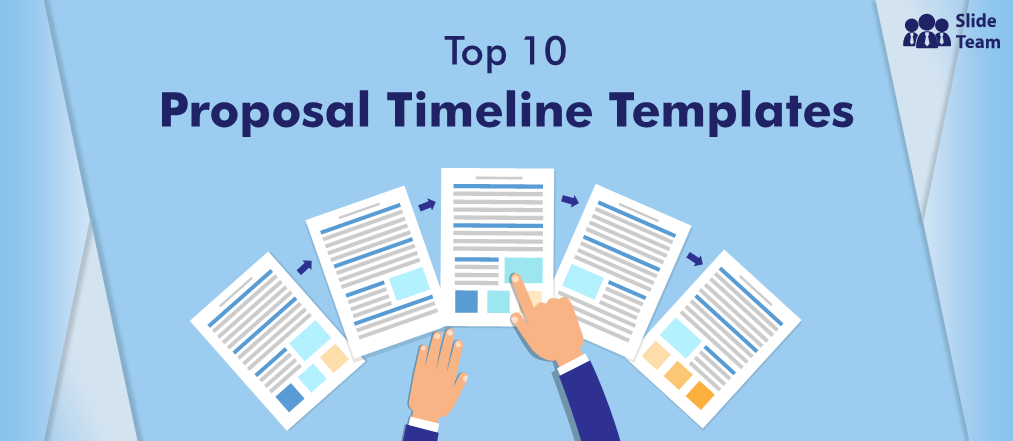
Mohammed Sameer
Imagine you're building a house, but you don't have a blueprint to guide you. How confident would you be of constructing a sturdy, functional home? Architectural delights aren’t built just on ideas and thought, these need tangible, actionable plans. Akin to building structures without blueprints, managing projects without a proposal timeline is Harakiri . A proposal timeline outlines a way to track your plan and ensure the achievement of objectives.
Did you know that without a clear timeline, 43% of projects go over budget? This can be costly and impact your reputation, especially if you're working in a competitive industry. Having a proposal timeline helps you resolve your major pain-points of staying within budget and meeting deadlines.
SlideTeam has compiled a list of the top Proposal Timeline PPT Templates . The 100% customizable nature of the templates provides you with the desired flexibility to edit your presentations. The content-ready slides give you the much-needed structure. Say goodbye to the stress and frustration of manual timeline creation and hello to a professional, effective proposal timeline. Get your hands on these templates today and take control of your project's success!
A proposal timeline is primarily a means of communicating important information regarding a project to stakeholders. Knowing the importance of communication, we have prepared an exclusive collection of the top 50 communication plan templates. Click here to explore.
Template 1: Event Proposal Timeline with Staging Preparation and Budget PPT Design
Presenting our exclusive Event Proposal Timeline PPT Template to help you tackle the challenges of organizing great events. With our pre-built template, you don't have to create a proposal from scratch. Our template offers insights into stage preparation and budgeting, helping you stay organized and on track. With its engaging and persuasive design, this template is perfect for event planners and coordinators looking to impress clients and stakeholders. Download now.
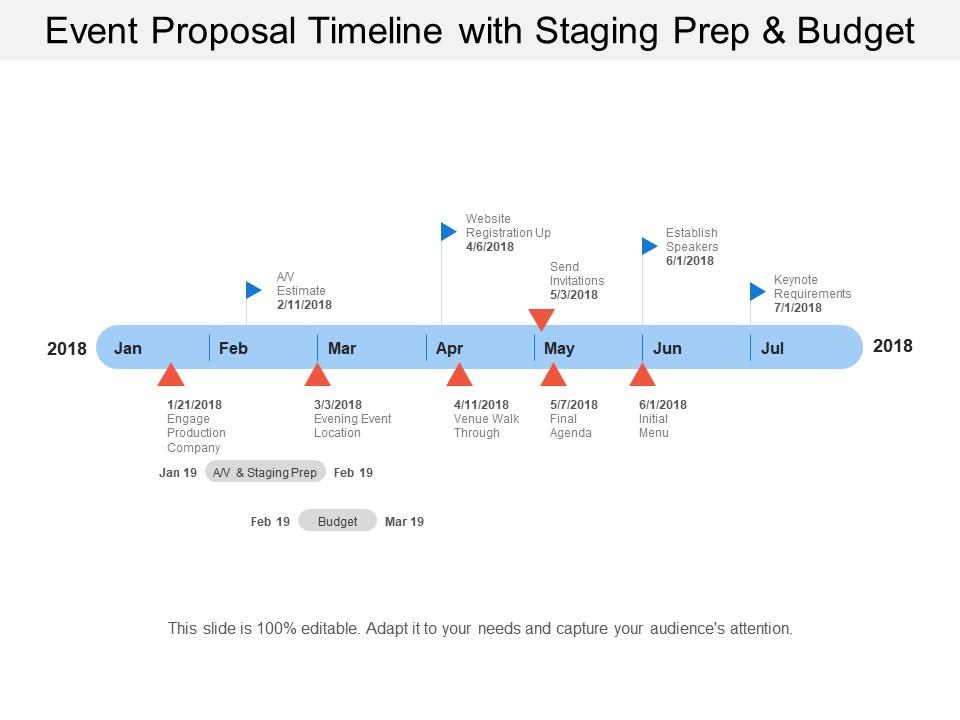
Download this template
Template 2: Event Proposal Showing Timeline and Checklist for Event Planning
Event planning can be a complex and overwhelming process, but it doesn't have to be. It is important that you hold a pre-event meeting at least three to four months before the actual show. Here's our Event Proposal Timeline and Checklist PPT Template to make your event planning journey seamless and stress-free. With its predesigned timeline and checklist, you'll never miss a beat or forget a task. A download of this template can help simplify your event planning process.
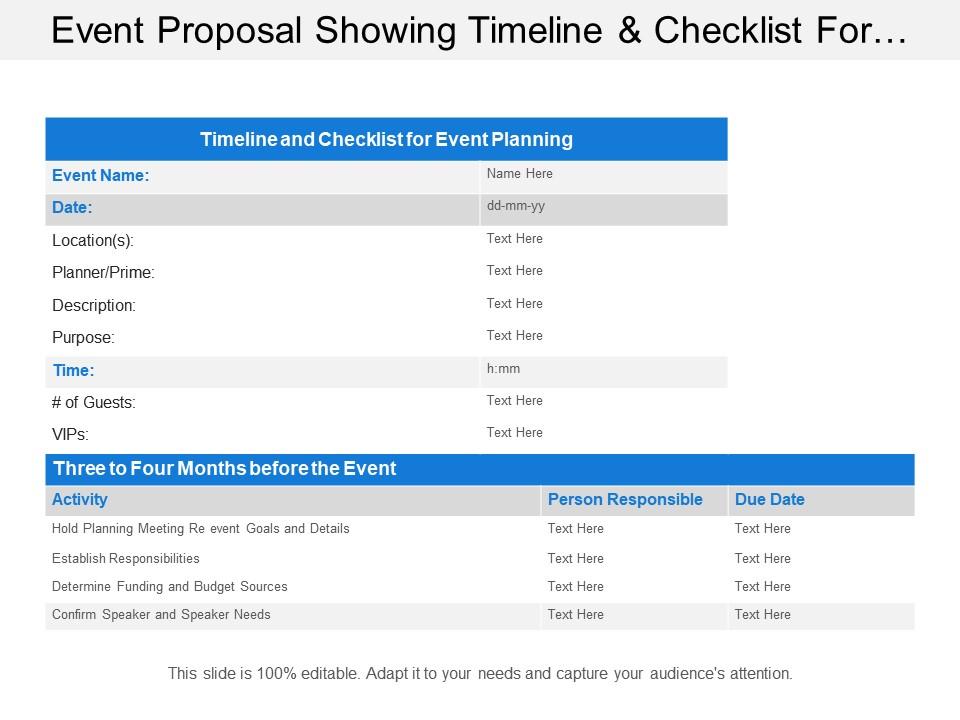
Get this template
Template 3: Ten-Day Timeline for Proposal Budget Preparation
Preparing proposal budgets can be intimidating. Our PPT template comes with a predesigned 10-day timeline that guides you through the entire proposal budget process, from setting up meetings to sending the draft proposal to your manager. With sample pointers on preparing a proposal budget, updating the budget as per feedback, and more, you'll have enough information to create a comprehensive and winning proposal budget. Get it now.
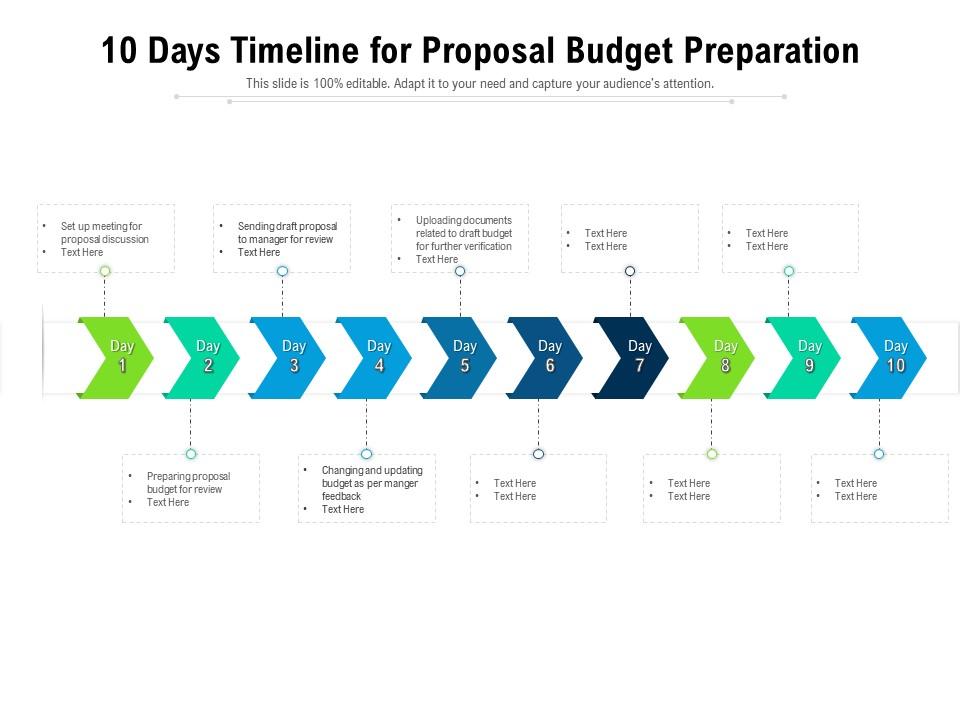

Template 4: Office Timeline with Proposal-Phase Design
Simplify your project management with our office timeline using this proposal phase PPT Template. This prebuilt template offers a comprehensive overview of different project phases, including proposal, analysis, design, documentation, review, implementation, testing, and deployment. This template saves you from spending hours creating a timeline from scratch. Download now.
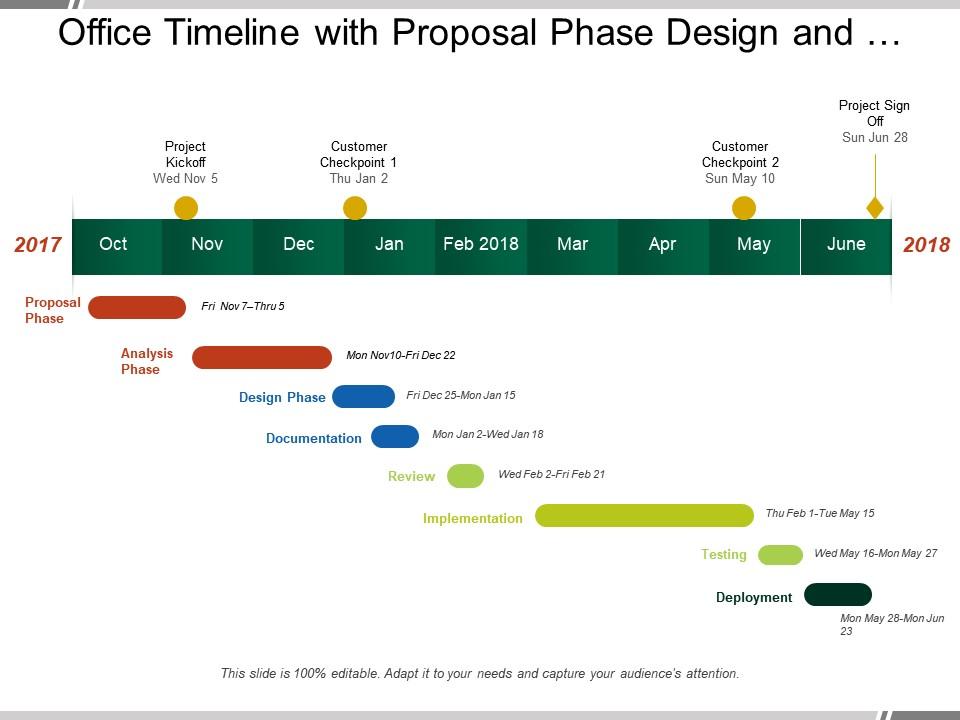
Template 5: SEO Proposal Project Timeline PPT Template
This dynamic template is the ultimate tool for digital marketers and SEO professionals. It has a weekly timeline that highlights key milestones. Our PPT Presentation covers all major elements of an SEO proposal, including Analytics and Keywords, Indexing, Ranking Factors, and Competitor Analysis. This template's engaging and persuasive design will leave a lasting impression on clients and stakeholders. Get it now.
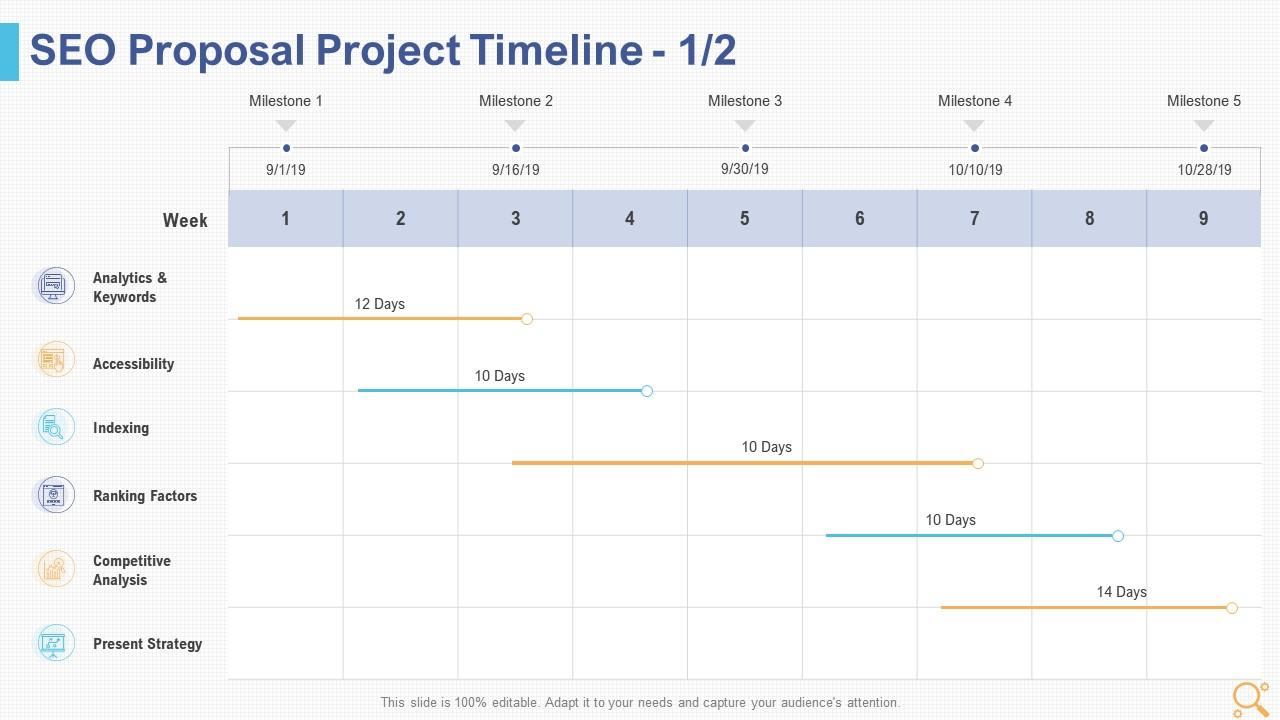
Template 6: Timeline for Corporate Travel Business Proposal PPT Framework
Unleash the full potential of your corporate travel business proposal with our visually stunning PPT Template. Impress clients and stakeholders with a unique timeline that showcases your organization's accomplishments and achievements. Build a clear roadmap to success with our intuitive and easy-to-use timeline that can be tailored to your specific needs. Download now.

Template 7: Product Marketing Campaign Proposal Timeline
Our Product Marketing Campaign Proposal Timeline template is designed to help you plan and execute your marketing efforts with ease. This PPT template comes with a unique six-month timeline that helps you create a well-structured and effective marketing campaign. Whether you're looking to raise brand awareness or promote a new product, this template has the tools you need to succeed. From a clear visual representation of your marketing timeline to detailed descriptions of each stage, this template is the perfect starting point for any product marketing campaign. Get it now.
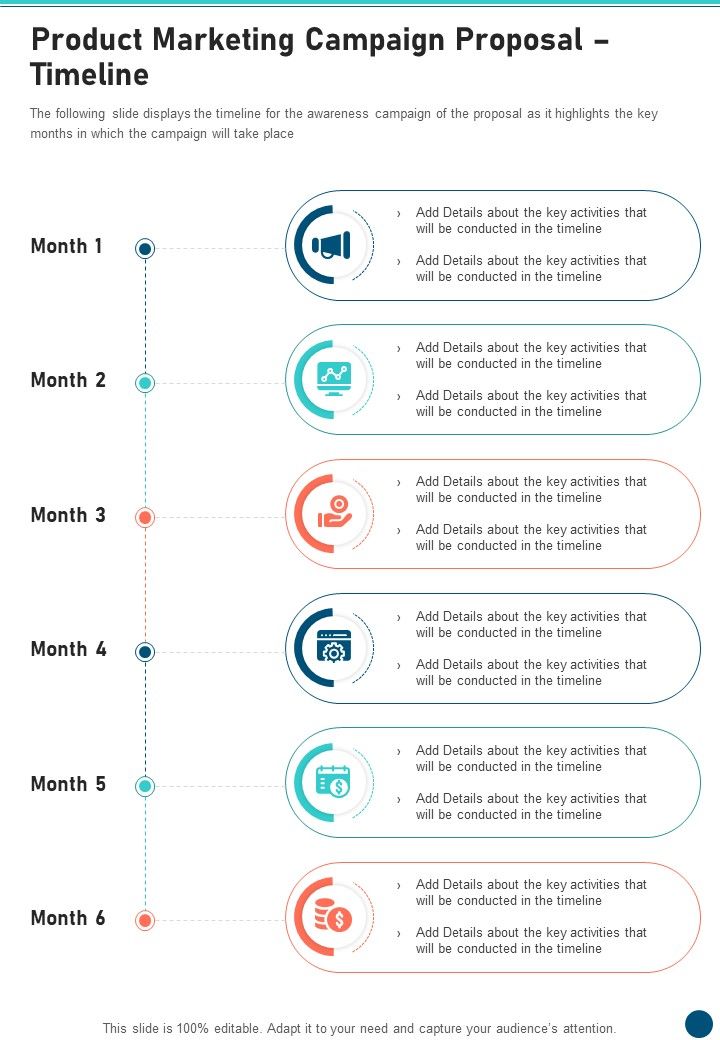
Template 8: Product Launch Program Proposal Timeline PPT Template
Introducing our exclusive product launch proposal PPT Template that is specifically designed to help you manage your product event launch. These presentation slides focus on product and service management, branding and marketing, and channel management. The clear and concise timeline helps you keep track of all important tasks and deadlines, ensuring that your launch runs smoothly and efficiently. Download it now.
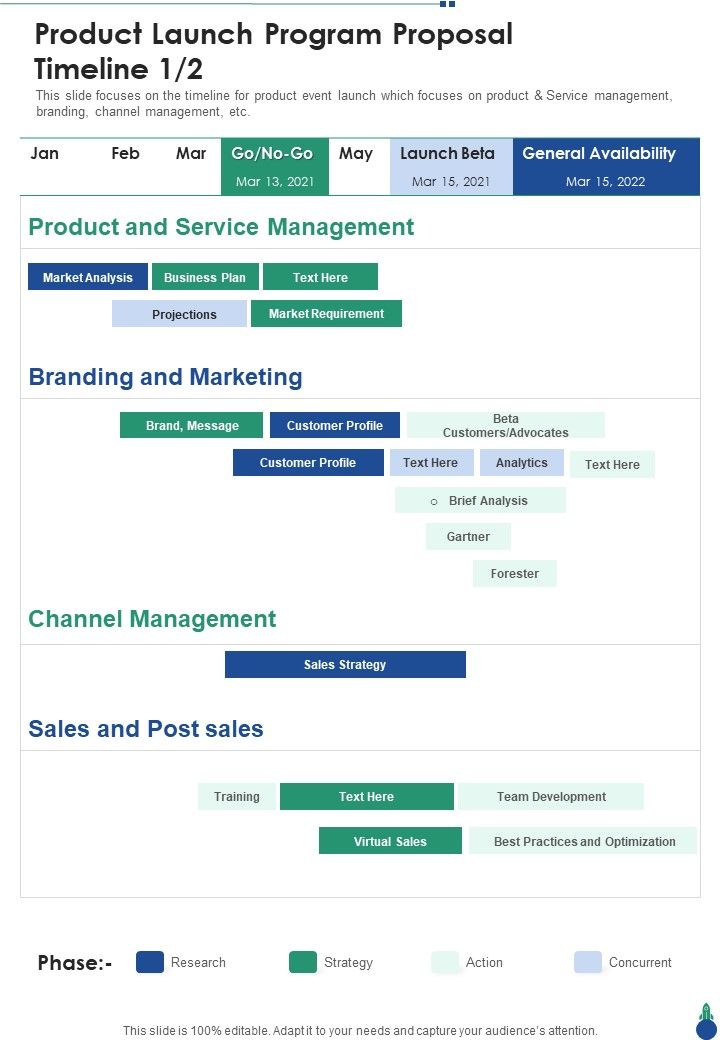
Template 9: Project Timeline for Engineering Consulting Proposal PPT Template
Our Project Timeline for Engineering Consulting Proposal template is the key to presenting a well-structured and professional proposal. This comprehensive PPT template is specifically designed for engineering consulting firms and focuses on the project timeline, making it easier to present complex information in a clear and concise manner. With this PPT Presentation, you can cover integral phases of an engineering consulting project, from project initiation and planning to design implementation and closeout. Download now.
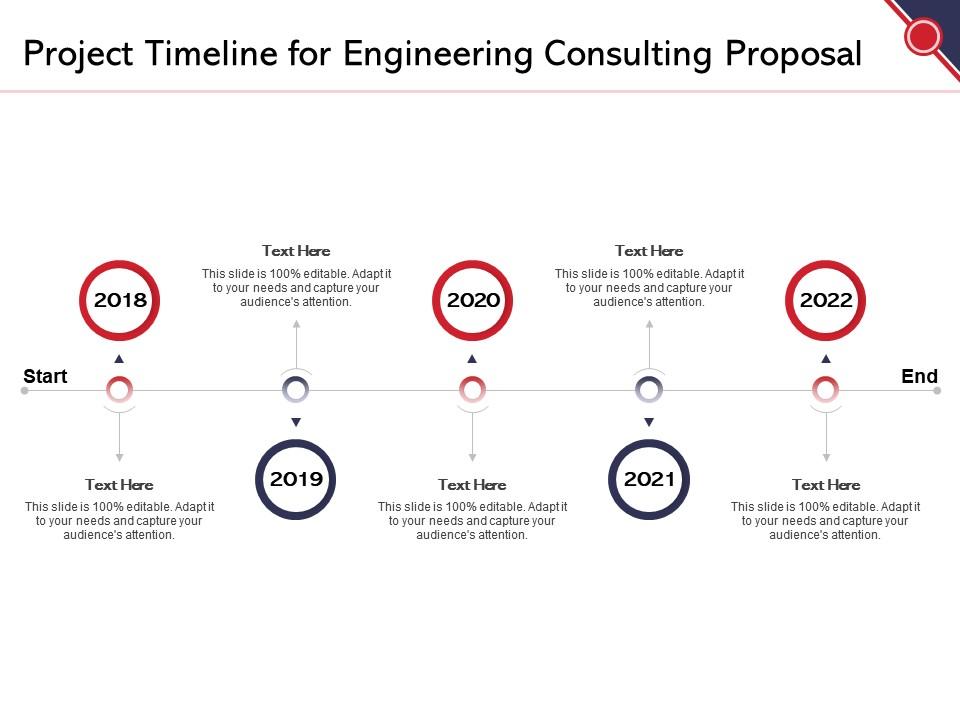
Template 10: Project Timeline for UX/UI Proposal Services
Deploy this PPT Template, specifically designed for UX/UI design services. It focuses on the four key phases of the UX/UI proposal process: discover, define, design, and development support. These presentation slides make it easy to communicate project milestones and deadlines, and the detailed task descriptions ensure everyone is on the same page. Whether you're proposing a new project or presenting progress updates, this template will help you showcase your expertise in UX/UI design and secure the support you need to succeed. Get it now.
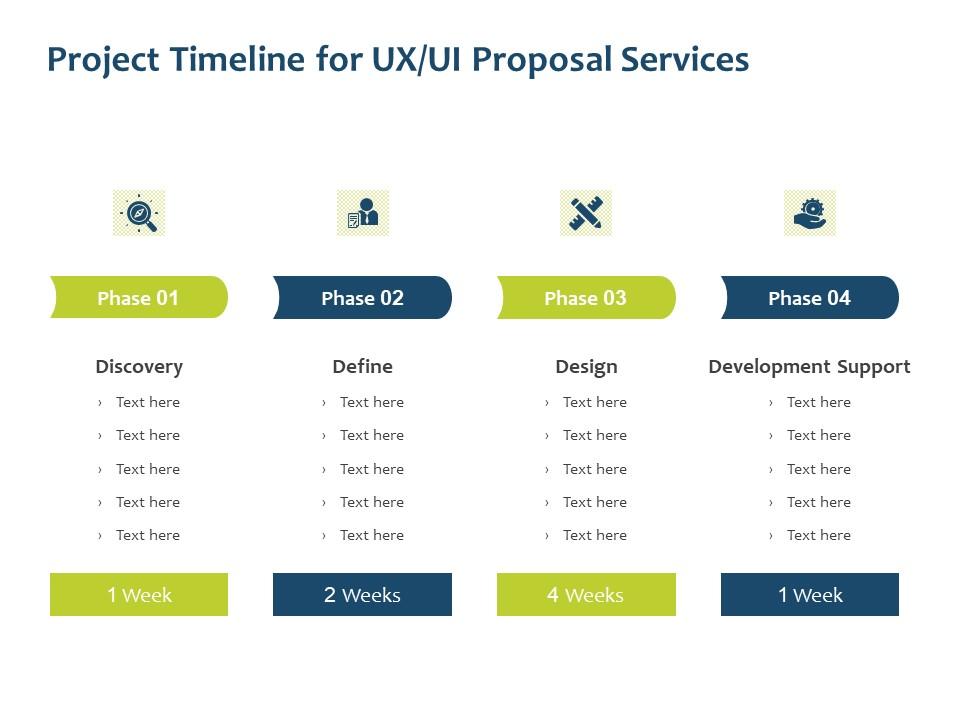
Professional Tool to Exhibit Planning
A well-crafted proposal timeline is essential to the success of any project. A clear and concise timeline helps keep everyone on the same page. Our Proposal Timeline PPT Templates offer a powerful solution for businesses and organizations looking to streamline their proposal processes. In today's competitive market, making a positive impression on clients is crucial, and our presentation slides offer a valuable tool for achieving this goal.
FAQs on Proposal Timelines
How do you write a timeline for a proposal.
Here are the steps to writing a timeline for a proposal:
- Determine the scope of the project: Identify the key milestones, tasks, and deadlines for the project.
- Gather relevant information: Collect the information needed to create the timeline, including start and end dates, task descriptions, and any dependencies.
- Choose a format: Decide on the format that will best communicate the timeline to the stakeholders. It can be a project management chart , a linear timeline, or a visual timeline using graphics.
- Create a draft: Using the information collected, create a draft of the timeline and organize the tasks in order.
- Review and refine: Review the draft timeline, refine it if needed, and ensure that it accurately reflects the project schedule.
- Present the timeline: Present the final timeline to the stakeholders, explaining how it fits into the overall project plan.
- Update as necessary: Regularly update the timeline as the project progresses to ensure that everyone is aware of any changes or delays.
Why is a timeline included in a proposal?
A timeline is included in the proposal for the following reasons:
- To show a clear and organized plan: A timeline provides a visual representation of the project plan and the timeline for completing each step. It illustrates the visionary nature of your business.
- To set expectations: A timeline sets expectations for the project schedule. It signals how a business deals with vendors and customers by having them primed to buy its products and services. Example: Apple is known to be a master of this, resulting in queues at the launch of every new version of the iPhone.
- To demonstrate competence: A well-crafted timeline shows to the proposal's stakeholders that the team has thought through the project plan and has a solid understanding of the timeline for completion.
- To track progress: A timeline serves as a tool for tracking progress and ensuring that the project is on track and that deadlines are being met.
- To manage resources: A timeline can help manage resources, including personnel, finances, and materials, by ensuring that the right resources are available at the right time.
Related posts:
- How to Design the Perfect Service Launch Presentation [Custom Launch Deck Included]
- Quarterly Business Review Presentation: All the Essential Slides You Need in Your Deck
- [Updated 2023] How to Design The Perfect Product Launch Presentation [Best Templates Included]
- 99% of the Pitches Fail! Find Out What Makes Any Startup a Success
Liked this blog? Please recommend us

Top 10 Business Consulting Proposal Templates For Industry Experts To Win Clients!

Top 10 Proposal Executive Summary Templates With Samples And Examples
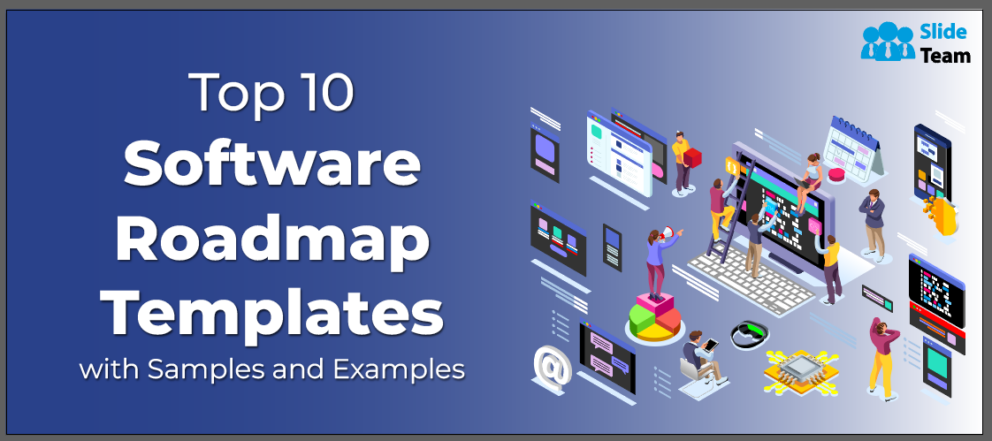
Top 10 Software Roadmap Templates with Samples and Examples
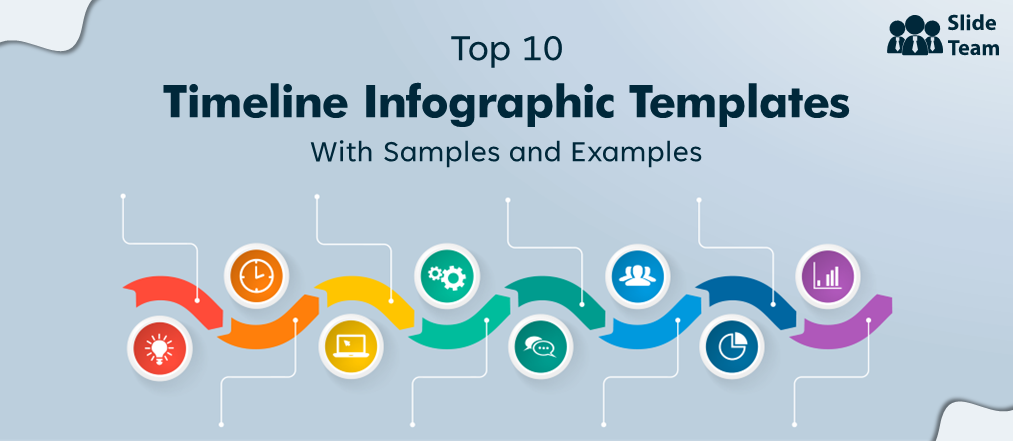
Top 10 Timeline Infographic Templates With Samples And Examples
This form is protected by reCAPTCHA - the Google Privacy Policy and Terms of Service apply.

Digital revolution powerpoint presentation slides

Sales funnel results presentation layouts
3d men joinning circular jigsaw puzzles ppt graphics icons

Business Strategic Planning Template For Organizations Powerpoint Presentation Slides

Future plan powerpoint template slide

Project Management Team Powerpoint Presentation Slides

Brand marketing powerpoint presentation slides

Launching a new service powerpoint presentation with slides go to market

Agenda powerpoint slide show

Four key metrics donut chart with percentage

Engineering and technology ppt inspiration example introduction continuous process improvement

Meet our team representing in circular format

17 Research Proposal Examples

A research proposal systematically and transparently outlines a proposed research project.
The purpose of a research proposal is to demonstrate a project’s viability and the researcher’s preparedness to conduct an academic study. It serves as a roadmap for the researcher.
The process holds value both externally (for accountability purposes and often as a requirement for a grant application) and intrinsic value (for helping the researcher to clarify the mechanics, purpose, and potential signficance of the study).
Key sections of a research proposal include: the title, abstract, introduction, literature review, research design and methods, timeline, budget, outcomes and implications, references, and appendix. Each is briefly explained below.
Watch my Guide: How to Write a Research Proposal
Get your Template for Writing your Research Proposal Here (With AI Prompts!)
Research Proposal Sample Structure
Title: The title should present a concise and descriptive statement that clearly conveys the core idea of the research projects. Make it as specific as possible. The reader should immediately be able to grasp the core idea of the intended research project. Often, the title is left too vague and does not help give an understanding of what exactly the study looks at.
Abstract: Abstracts are usually around 250-300 words and provide an overview of what is to follow – including the research problem , objectives, methods, expected outcomes, and significance of the study. Use it as a roadmap and ensure that, if the abstract is the only thing someone reads, they’ll get a good fly-by of what will be discussed in the peice.
Introduction: Introductions are all about contextualization. They often set the background information with a statement of the problem. At the end of the introduction, the reader should understand what the rationale for the study truly is. I like to see the research questions or hypotheses included in the introduction and I like to get a good understanding of what the significance of the research will be. It’s often easiest to write the introduction last
Literature Review: The literature review dives deep into the existing literature on the topic, demosntrating your thorough understanding of the existing literature including themes, strengths, weaknesses, and gaps in the literature. It serves both to demonstrate your knowledge of the field and, to demonstrate how the proposed study will fit alongside the literature on the topic. A good literature review concludes by clearly demonstrating how your research will contribute something new and innovative to the conversation in the literature.
Research Design and Methods: This section needs to clearly demonstrate how the data will be gathered and analyzed in a systematic and academically sound manner. Here, you need to demonstrate that the conclusions of your research will be both valid and reliable. Common points discussed in the research design and methods section include highlighting the research paradigm, methodologies, intended population or sample to be studied, data collection techniques, and data analysis procedures . Toward the end of this section, you are encouraged to also address ethical considerations and limitations of the research process , but also to explain why you chose your research design and how you are mitigating the identified risks and limitations.
Timeline: Provide an outline of the anticipated timeline for the study. Break it down into its various stages (including data collection, data analysis, and report writing). The goal of this section is firstly to establish a reasonable breakdown of steps for you to follow and secondly to demonstrate to the assessors that your project is practicable and feasible.
Budget: Estimate the costs associated with the research project and include evidence for your estimations. Typical costs include staffing costs, equipment, travel, and data collection tools. When applying for a scholarship, the budget should demonstrate that you are being responsible with your expensive and that your funding application is reasonable.
Expected Outcomes and Implications: A discussion of the anticipated findings or results of the research, as well as the potential contributions to the existing knowledge, theory, or practice in the field. This section should also address the potential impact of the research on relevant stakeholders and any broader implications for policy or practice.
References: A complete list of all the sources cited in the research proposal, formatted according to the required citation style. This demonstrates the researcher’s familiarity with the relevant literature and ensures proper attribution of ideas and information.
Appendices (if applicable): Any additional materials, such as questionnaires, interview guides, or consent forms, that provide further information or support for the research proposal. These materials should be included as appendices at the end of the document.
Research Proposal Examples
Research proposals often extend anywhere between 2,000 and 15,000 words in length. The following snippets are samples designed to briefly demonstrate what might be discussed in each section.
1. Education Studies Research Proposals
See some real sample pieces:
- Assessment of the perceptions of teachers towards a new grading system
- Does ICT use in secondary classrooms help or hinder student learning?
- Digital technologies in focus project
- Urban Middle School Teachers’ Experiences of the Implementation of
- Restorative Justice Practices
- Experiences of students of color in service learning
Consider this hypothetical education research proposal:
The Impact of Game-Based Learning on Student Engagement and Academic Performance in Middle School Mathematics
Abstract: The proposed study will explore multiplayer game-based learning techniques in middle school mathematics curricula and their effects on student engagement. The study aims to contribute to the current literature on game-based learning by examining the effects of multiplayer gaming in learning.
Introduction: Digital game-based learning has long been shunned within mathematics education for fears that it may distract students or lower the academic integrity of the classrooms. However, there is emerging evidence that digital games in math have emerging benefits not only for engagement but also academic skill development. Contributing to this discourse, this study seeks to explore the potential benefits of multiplayer digital game-based learning by examining its impact on middle school students’ engagement and academic performance in a mathematics class.
Literature Review: The literature review has identified gaps in the current knowledge, namely, while game-based learning has been extensively explored, the role of multiplayer games in supporting learning has not been studied.
Research Design and Methods: This study will employ a mixed-methods research design based upon action research in the classroom. A quasi-experimental pre-test/post-test control group design will first be used to compare the academic performance and engagement of middle school students exposed to game-based learning techniques with those in a control group receiving instruction without the aid of technology. Students will also be observed and interviewed in regard to the effect of communication and collaboration during gameplay on their learning.
Timeline: The study will take place across the second term of the school year with a pre-test taking place on the first day of the term and the post-test taking place on Wednesday in Week 10.
Budget: The key budgetary requirements will be the technologies required, including the subscription cost for the identified games and computers.
Expected Outcomes and Implications: It is expected that the findings will contribute to the current literature on game-based learning and inform educational practices, providing educators and policymakers with insights into how to better support student achievement in mathematics.
2. Psychology Research Proposals
See some real examples:
- A situational analysis of shared leadership in a self-managing team
- The effect of musical preference on running performance
- Relationship between self-esteem and disordered eating amongst adolescent females
Consider this hypothetical psychology research proposal:
The Effects of Mindfulness-Based Interventions on Stress Reduction in College Students
Abstract: This research proposal examines the impact of mindfulness-based interventions on stress reduction among college students, using a pre-test/post-test experimental design with both quantitative and qualitative data collection methods .
Introduction: College students face heightened stress levels during exam weeks. This can affect both mental health and test performance. This study explores the potential benefits of mindfulness-based interventions such as meditation as a way to mediate stress levels in the weeks leading up to exam time.
Literature Review: Existing research on mindfulness-based meditation has shown the ability for mindfulness to increase metacognition, decrease anxiety levels, and decrease stress. Existing literature has looked at workplace, high school and general college-level applications. This study will contribute to the corpus of literature by exploring the effects of mindfulness directly in the context of exam weeks.
Research Design and Methods: Participants ( n= 234 ) will be randomly assigned to either an experimental group, receiving 5 days per week of 10-minute mindfulness-based interventions, or a control group, receiving no intervention. Data will be collected through self-report questionnaires, measuring stress levels, semi-structured interviews exploring participants’ experiences, and students’ test scores.
Timeline: The study will begin three weeks before the students’ exam week and conclude after each student’s final exam. Data collection will occur at the beginning (pre-test of self-reported stress levels) and end (post-test) of the three weeks.
Expected Outcomes and Implications: The study aims to provide evidence supporting the effectiveness of mindfulness-based interventions in reducing stress among college students in the lead up to exams, with potential implications for mental health support and stress management programs on college campuses.
3. Sociology Research Proposals
- Understanding emerging social movements: A case study of ‘Jersey in Transition’
- The interaction of health, education and employment in Western China
- Can we preserve lower-income affordable neighbourhoods in the face of rising costs?
Consider this hypothetical sociology research proposal:
The Impact of Social Media Usage on Interpersonal Relationships among Young Adults
Abstract: This research proposal investigates the effects of social media usage on interpersonal relationships among young adults, using a longitudinal mixed-methods approach with ongoing semi-structured interviews to collect qualitative data.
Introduction: Social media platforms have become a key medium for the development of interpersonal relationships, particularly for young adults. This study examines the potential positive and negative effects of social media usage on young adults’ relationships and development over time.
Literature Review: A preliminary review of relevant literature has demonstrated that social media usage is central to development of a personal identity and relationships with others with similar subcultural interests. However, it has also been accompanied by data on mental health deline and deteriorating off-screen relationships. The literature is to-date lacking important longitudinal data on these topics.
Research Design and Methods: Participants ( n = 454 ) will be young adults aged 18-24. Ongoing self-report surveys will assess participants’ social media usage, relationship satisfaction, and communication patterns. A subset of participants will be selected for longitudinal in-depth interviews starting at age 18 and continuing for 5 years.
Timeline: The study will be conducted over a period of five years, including recruitment, data collection, analysis, and report writing.
Expected Outcomes and Implications: This study aims to provide insights into the complex relationship between social media usage and interpersonal relationships among young adults, potentially informing social policies and mental health support related to social media use.
4. Nursing Research Proposals
- Does Orthopaedic Pre-assessment clinic prepare the patient for admission to hospital?
- Nurses’ perceptions and experiences of providing psychological care to burns patients
- Registered psychiatric nurse’s practice with mentally ill parents and their children
Consider this hypothetical nursing research proposal:
The Influence of Nurse-Patient Communication on Patient Satisfaction and Health Outcomes following Emergency Cesarians
Abstract: This research will examines the impact of effective nurse-patient communication on patient satisfaction and health outcomes for women following c-sections, utilizing a mixed-methods approach with patient surveys and semi-structured interviews.
Introduction: It has long been known that effective communication between nurses and patients is crucial for quality care. However, additional complications arise following emergency c-sections due to the interaction between new mother’s changing roles and recovery from surgery.
Literature Review: A review of the literature demonstrates the importance of nurse-patient communication, its impact on patient satisfaction, and potential links to health outcomes. However, communication between nurses and new mothers is less examined, and the specific experiences of those who have given birth via emergency c-section are to date unexamined.
Research Design and Methods: Participants will be patients in a hospital setting who have recently had an emergency c-section. A self-report survey will assess their satisfaction with nurse-patient communication and perceived health outcomes. A subset of participants will be selected for in-depth interviews to explore their experiences and perceptions of the communication with their nurses.
Timeline: The study will be conducted over a period of six months, including rolling recruitment, data collection, analysis, and report writing within the hospital.
Expected Outcomes and Implications: This study aims to provide evidence for the significance of nurse-patient communication in supporting new mothers who have had an emergency c-section. Recommendations will be presented for supporting nurses and midwives in improving outcomes for new mothers who had complications during birth.
5. Social Work Research Proposals
- Experiences of negotiating employment and caring responsibilities of fathers post-divorce
- Exploring kinship care in the north region of British Columbia
Consider this hypothetical social work research proposal:
The Role of a Family-Centered Intervention in Preventing Homelessness Among At-Risk Youthin a working-class town in Northern England
Abstract: This research proposal investigates the effectiveness of a family-centered intervention provided by a local council area in preventing homelessness among at-risk youth. This case study will use a mixed-methods approach with program evaluation data and semi-structured interviews to collect quantitative and qualitative data .
Introduction: Homelessness among youth remains a significant social issue. This study aims to assess the effectiveness of family-centered interventions in addressing this problem and identify factors that contribute to successful prevention strategies.
Literature Review: A review of the literature has demonstrated several key factors contributing to youth homelessness including lack of parental support, lack of social support, and low levels of family involvement. It also demonstrates the important role of family-centered interventions in addressing this issue. Drawing on current evidence, this study explores the effectiveness of one such intervention in preventing homelessness among at-risk youth in a working-class town in Northern England.
Research Design and Methods: The study will evaluate a new family-centered intervention program targeting at-risk youth and their families. Quantitative data on program outcomes, including housing stability and family functioning, will be collected through program records and evaluation reports. Semi-structured interviews with program staff, participants, and relevant stakeholders will provide qualitative insights into the factors contributing to program success or failure.
Timeline: The study will be conducted over a period of six months, including recruitment, data collection, analysis, and report writing.
Budget: Expenses include access to program evaluation data, interview materials, data analysis software, and any related travel costs for in-person interviews.
Expected Outcomes and Implications: This study aims to provide evidence for the effectiveness of family-centered interventions in preventing youth homelessness, potentially informing the expansion of or necessary changes to social work practices in Northern England.
Research Proposal Template
Get your Detailed Template for Writing your Research Proposal Here (With AI Prompts!)
This is a template for a 2500-word research proposal. You may find it difficult to squeeze everything into this wordcount, but it’s a common wordcount for Honors and MA-level dissertations.
Your research proposal is where you really get going with your study. I’d strongly recommend working closely with your teacher in developing a research proposal that’s consistent with the requirements and culture of your institution, as in my experience it varies considerably. The above template is from my own courses that walk students through research proposals in a British School of Education.

Chris Drew (PhD)
Dr. Chris Drew is the founder of the Helpful Professor. He holds a PhD in education and has published over 20 articles in scholarly journals. He is the former editor of the Journal of Learning Development in Higher Education. [Image Descriptor: Photo of Chris]
- Chris Drew (PhD) https://helpfulprofessor.com/author/chris-drew-phd/ 5 Top Tips for Succeeding at University
- Chris Drew (PhD) https://helpfulprofessor.com/author/chris-drew-phd/ 50 Durable Goods Examples
- Chris Drew (PhD) https://helpfulprofessor.com/author/chris-drew-phd/ 100 Consumer Goods Examples
- Chris Drew (PhD) https://helpfulprofessor.com/author/chris-drew-phd/ 30 Globalization Pros and Cons
8 thoughts on “17 Research Proposal Examples”
Very excellent research proposals
very helpful
Very helpful
Dear Sir, I need some help to write an educational research proposal. Thank you.

Hi Levi, use the site search bar to ask a question and I’ll likely have a guide already written for your specific question. Thanks for reading!
very good research proposal
Thank you so much sir! ❤️
Very helpful 👌
Leave a Comment Cancel Reply
Your email address will not be published. Required fields are marked *
- Skip to Content
- Skip to Main Navigation
- Skip to Search

Indiana University Indianapolis Indiana University Indianapolis IU Indianapolis

- Staff Directory
- Our Mission
- Advisory Council
- Bepko Student Advisory Board
- About the Program
- About Chancellor Bepko
- 2023 Scholars
- 2022 Scholars
- 2021 Scholars
- 2020 Scholars
- Meet the Fellows
- Prospective Freshmen
- Current & Transfer Students
- Courses & Honors Credit
- Advising Syllabus
- Graduating with Honors
- Honors Minors
- HON-H 200 Intro to Honors Mentor Program
- Success Stories
- Student Organizations
- Peer Mentor Program
- Honors Housing
- Research Opportunities
- Study Abroad
- Service Learning
- Experiential Learning
- Student Showcase
- Honors News
- Honors Events
- Class of 2023
- Class of 2022
- Class of 2021
- Class of 2020
- Student Portal
- Honors Contracts & Credit Forms
Honors Contract
Complete an honors contract, general information.
When you enter into an Honors Contract with a faculty member, you are agreeing to engage in work clearly beyond what is required for a regular undergraduate course. Simply increasing the quantity of coursework does not constitute an Honors Contract project. Projects can include—but are not limited to—the following examples:
- Completing an independent project that employs research methods taught in the course
- Writing a research paper that expands upon a topic covered in the course
- Producing teaching materials, such as creating a test, new handouts, or PowerPoint presentation for a course
- Researching a topic and teaching a class session to share your findings
- Designing and completing a special project, performance, or product
Students who entered the Honors College during or after fall 2022 should plan to add their honors project and reflection to their ePortfolio. More information about the ePortfolio requirement will be shared in HON-H 200.
Information for students
Please complete the following items prior to submitting the application form:
- See examples of Honors Contracts on the Honors College Canvas.
- Project title, project description, and details (page or presentation length, for example), and weekly timeline to completion. You will need to submit these pieces of information on the contract proposal form.
- How your project might fulfill the expectations of an engaging experience such as research, service learning, international study, or other opportunities to apply classroom learning.
- How your project might contribute to the IUPUI and Honors College learning goals such as developing your skills as a problem solver, communicator, innovator, or community contributor.
- After you click to submit your Honors contract proposal, your professor will receive a request to approve your project to indicate they agree to work with you. Both of these steps must be completed by the deadline.
Toward the end of the semester, you will submit your completed project to your instructor for evaluation. Projects are not submitted to the Honors College.
To receive Honors credit, you must receive a grade of B or better in the class. While the course may count toward your degree if you receive a grade lower than B, it will not count toward the Honors notation.
Information for faculty
The Honors Contract is not a substitute for regular work. To receive Honors credit, the student must complete all regular coursework as well as the Honors contract and receive at least a B (not a B-) overall in the class.
Honors contracts must be completed via the online form, submitted, and approved by faculty members. You should receive an email directing you to approve the student's Honors Contract proposal.
Honors College staff will review all contracts and notify each student of approval or the need for revision. You are responsible for determining the criteria for evaluating the student's honors contract work.
You will assign one grade at the end of the semester which will serve as both the Honors project grade and the grade for the course. You will determine the weight of the Honors project in calculating the final grade.
No instructor or department is required to accept Honors Contracts. Departments may choose to set up specific guidelines for all students with Honors Contracts within the department. If such policies are established, please inform the Honors College Office.
For more information, please contact Lisa Ruch .
Example: Proposal and timeline
For my Honors contract in P105: Giving and Volunteering in America, I will conduct a philanthropic service-learning project. For this project, I will gather, inform, and lead a group of IUPUI student volunteers in the upcoming Walk to Defeat ALS. This event is run by The ALS Association to help raise funds to allow local chapters to sustain care services and support research. In conjunction with organizing the volunteers, I will organize a walk team. Goals for this project include: acquiring at least 20 volunteers, a 10 person walk team, and raising at least $500 to be donated to the ALS Association. To ensure this is a successful event and service opportunity, I will have an open dialogue with the Indiana ALS chapter. This includes making several trips to their office for sit down meetings and phone calls to ensure I am following their guidelines as I am the face of their organization at IUPUI. I will also be keeping a detailed journal of my daily activities as they relate to the process of setting up and running the philanthropic service-learning project and will write a final reflection of four pages drawing on concepts and material from the course.
September 2: Formalize honors contract September 6: Communicate with ALS Association September 9: Design marketing materials including flyers, email communication, social media, and a marketing plan September 12: Hold an informational meeting September 13-19: Conduct additional recruitment September 13-26: Fundraise with the walk team September 27: Day of event September 29: Thank and recognize volunteers October 20: Submit final reflection paper. The entire Honors Project will be worth 150 points of 18% of the final course grade.
More examples of Honors Contracts in all academic schools are located on the Honors College Resource Site on Canvas.
Required: Reflection essay
At the end of the semester, you will be required to submit a 500-800 word reflection paper about your Honors work in the course. We will send you a link to the form that you will use to submit this reflection toward the end of the semester. This reflection will include a brief description of your experience followed by your personal feelings, insights, opinions, and observations regarding its significance and its impact on you and your future.
Begin application
The form is a fully digital application and does not require you to bring in any paper materials. If you have any questions, please contact [email protected] .
Honors College social media channels

An official website of the United States government
Here’s how you know
The .gov means it’s official. Federal government websites often end in .gov or .mil. Before sharing sensitive information, make sure you’re on a federal government site.
The site is secure. The https:// ensures that you are connecting to the official website and that any information you provide is encrypted and transmitted securely.
Take action
- Report an antitrust violation
- File adjudicative documents
- Find banned debt collectors
- View competition guidance
- Competition Matters Blog
New HSR thresholds and filing fees for 2024
View all Competition Matters Blog posts
We work to advance government policies that protect consumers and promote competition.
View Policy
Search or browse the Legal Library
Find legal resources and guidance to understand your business responsibilities and comply with the law.
Browse legal resources
- Find policy statements
- Submit a public comment

Vision and Priorities
Memo from Chair Lina M. Khan to commission staff and commissioners regarding the vision and priorities for the FTC.
Technology Blog
Consumer facing applications: a quote book from the tech summit on ai.
View all Technology Blog posts
Advice and Guidance
Learn more about your rights as a consumer and how to spot and avoid scams. Find the resources you need to understand how consumer protection law impacts your business.
- Report fraud
- Report identity theft
- Register for Do Not Call
- Sign up for consumer alerts
- Get Business Blog updates
- Get your free credit report
- Find refund cases
- Order bulk publications
- Consumer Advice
- Shopping and Donating
- Credit, Loans, and Debt
- Jobs and Making Money
- Unwanted Calls, Emails, and Texts
- Identity Theft and Online Security
- Business Guidance
- Advertising and Marketing
- Credit and Finance
- Privacy and Security
- By Industry
- For Small Businesses
- Browse Business Guidance Resources
- Business Blog
Servicemembers: Your tool for financial readiness
Visit militaryconsumer.gov
Get consumer protection basics, plain and simple
Visit consumer.gov
Learn how the FTC protects free enterprise and consumers
Visit Competition Counts
Looking for competition guidance?
- Competition Guidance
News and Events
Latest news, ftc, doj submit joint comment to ferc warning of common ownership competition risks in the public utilities industry.
View News and Events
Upcoming Event
Commissioner bedoya speaks at loyola university school of law’s 24th annual loyola antitrust colloquium.
View more Events
Sign up for the latest news
Follow us on social media
--> --> --> --> -->

Playing it Safe: Explore the FTC's Top Video Game Cases
Learn about the FTC's notable video game cases and what our agency is doing to keep the public safe.
Latest Data Visualization

FTC Refunds to Consumers
Explore refund statistics including where refunds were sent and the dollar amounts refunded with this visualization.
About the FTC
Our mission is protecting the public from deceptive or unfair business practices and from unfair methods of competition through law enforcement, advocacy, research, and education.
Learn more about the FTC

Meet the Chair
Lina M. Khan was sworn in as Chair of the Federal Trade Commission on June 15, 2021.
Chair Lina M. Khan
Looking for legal documents or records? Search the Legal Library instead.
- Cases and Proceedings
- Premerger Notification Program
- Merger Review
- Anticompetitive Practices
- Competition and Consumer Protection Guidance Documents
- Warning Letters
- Consumer Sentinel Network
- Criminal Liaison Unit
- FTC Refund Programs
- Notices of Penalty Offenses
- Advocacy and Research
- Advisory Opinions
- Cooperation Agreements
- Federal Register Notices
- Public Comments
- Policy Statements
- International
- Military Consumer
- Consumer.gov
- Bulk Publications
- Data and Visualizations
- Stay Connected
- Commissioners and Staff
- Bureaus and Offices
- Budget and Strategy
- Office of Inspector General
- Careers at the FTC
Fact Sheet on FTC’s Proposed Final Noncompete Rule
- Competition
- Office of Policy Planning
- Bureau of Competition
The following outline provides a high-level overview of the FTC’s proposed final rule :
- Specifically, the final rule provides that it is an unfair method of competition—and therefore a violation of Section 5 of the FTC Act—for employers to enter into noncompetes with workers after the effective date.
- Fewer than 1% of workers are estimated to be senior executives under the final rule.
- Specifically, the final rule defines the term “senior executive” to refer to workers earning more than $151,164 annually who are in a “policy-making position.”
- Reduced health care costs: $74-$194 billion in reduced spending on physician services over the next decade.
- New business formation: 2.7% increase in the rate of new firm formation, resulting in over 8,500 additional new businesses created each year.
- This reflects an estimated increase of about 3,000 to 5,000 new patents in the first year noncompetes are banned, rising to about 30,000-53,000 in the tenth year.
- This represents an estimated increase of 11-19% annually over a ten-year period.
- The average worker’s earnings will rise an estimated extra $524 per year.
The Federal Trade Commission develops policy initiatives on issues that affect competition, consumers, and the U.S. economy. The FTC will never demand money, make threats, tell you to transfer money, or promise you a prize. Follow the FTC on social media , read consumer alerts and the business blog , and sign up to get the latest FTC news and alerts .
Contact Information
Media contact.
Victoria Graham Office of Public Affairs 415-848-5121
Numbers, Facts and Trends Shaping Your World
Read our research on:
Full Topic List
Regions & Countries
- Publications
- Our Methods
- Short Reads
- Tools & Resources
Read Our Research On:
Key facts about Americans and guns
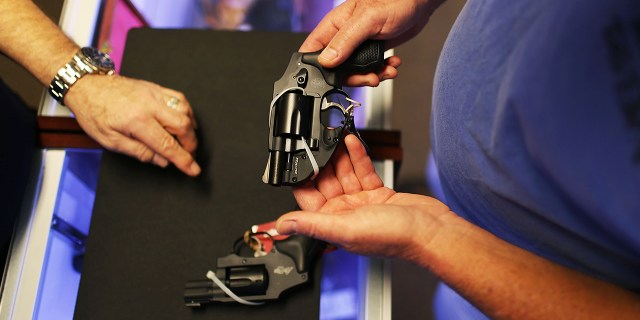
Guns are deeply ingrained in American society and the nation’s political debates.
The Second Amendment to the United States Constitution guarantees the right to bear arms, and about a third of U.S. adults say they personally own a gun. At the same time, in response to concerns such as rising gun death rates and mass shootings , President Joe Biden has proposed gun policy legislation that would expand on the bipartisan gun safety bill Congress passed last year.
Here are some key findings about Americans’ views of gun ownership, gun policy and other subjects, drawn primarily from a Pew Research Center survey conducted in June 2023 .
Pew Research Center conducted this analysis to summarize key facts about Americans and guns. We used data from recent Center surveys to provide insights into Americans’ views on gun policy and how those views have changed over time, as well as to examine the proportion of adults who own guns and their reasons for doing so.
The analysis draws primarily from a survey of 5,115 U.S. adults conducted from June 5 to June 11, 2023. Everyone who took part in the surveys cited is a member of the Center’s American Trends Panel (ATP), an online survey panel that is recruited through national, random sampling of residential addresses. This way nearly all U.S. adults have a chance of selection. The survey is weighted to be representative of the U.S. adult population by gender, race, ethnicity, partisan affiliation, education and other categories. Read more about the ATP’s methodology .
Here are the questions used for the analysis on gun ownership , the questions used for the analysis on gun policy , and the survey’s methodology .
Additional information about the fall 2022 survey of parents and its methodology can be found at the link in the text of this post.
Measuring gun ownership in the United States comes with unique challenges. Unlike many demographic measures, there is not a definitive data source from the government or elsewhere on how many American adults own guns.
The Pew Research Center survey conducted June 5-11, 2023, on the Center’s American Trends Panel, asks about gun ownership using two separate questions to measure personal and household ownership. About a third of adults (32%) say they own a gun, while another 10% say they do not personally own a gun but someone else in their household does. These shares have changed little from surveys conducted in 2021 and 2017 . In each of those surveys, 30% reported they owned a gun.
These numbers are largely consistent with rates of gun ownership reported by Gallup , but somewhat higher than those reported by NORC’s General Social Survey . Those surveys also find only modest changes in recent years.
The FBI maintains data on background checks on individuals attempting to purchase firearms in the United States. The FBI reported a surge in background checks in 2020 and 2021, during the coronavirus pandemic. The number of federal background checks declined in 2022 and through the first half of this year, according to FBI statistics .
About four-in-ten U.S. adults say they live in a household with a gun, including 32% who say they personally own one, according to an August report based on our June survey. These numbers are virtually unchanged since the last time we asked this question in 2021.
There are differences in gun ownership rates by political affiliation, gender, community type and other factors.
- Republicans and Republican-leaning independents are more than twice as likely as Democrats and Democratic leaners to say they personally own a gun (45% vs. 20%).
- 40% of men say they own a gun, compared with 25% of women.
- 47% of adults living in rural areas report personally owning a firearm, as do smaller shares of those who live in suburbs (30%) or urban areas (20%).
- 38% of White Americans own a gun, compared with smaller shares of Black (24%), Hispanic (20%) and Asian (10%) Americans.
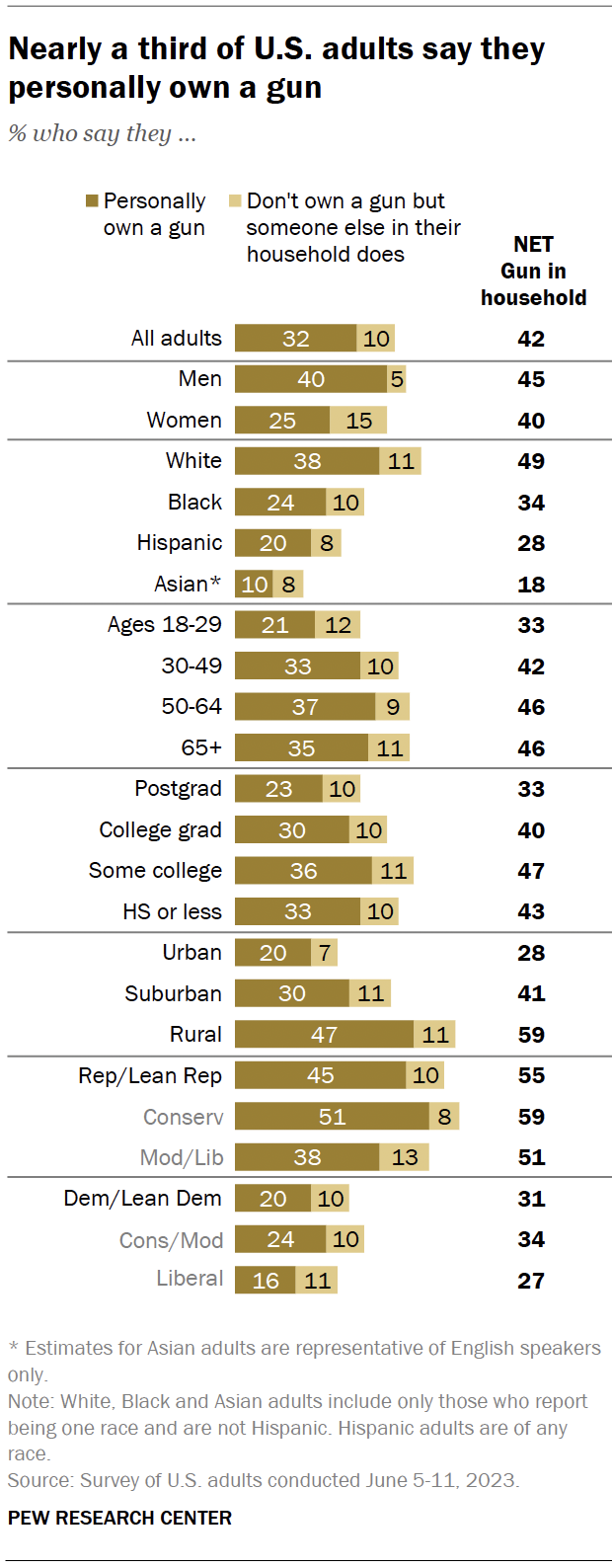
Personal protection tops the list of reasons gun owners give for owning a firearm. About three-quarters (72%) of gun owners say that protection is a major reason they own a gun. Considerably smaller shares say that a major reason they own a gun is for hunting (32%), for sport shooting (30%), as part of a gun collection (15%) or for their job (7%).
The reasons behind gun ownership have changed only modestly since our 2017 survey of attitudes toward gun ownership and gun policies. At that time, 67% of gun owners cited protection as a major reason they owned a firearm.
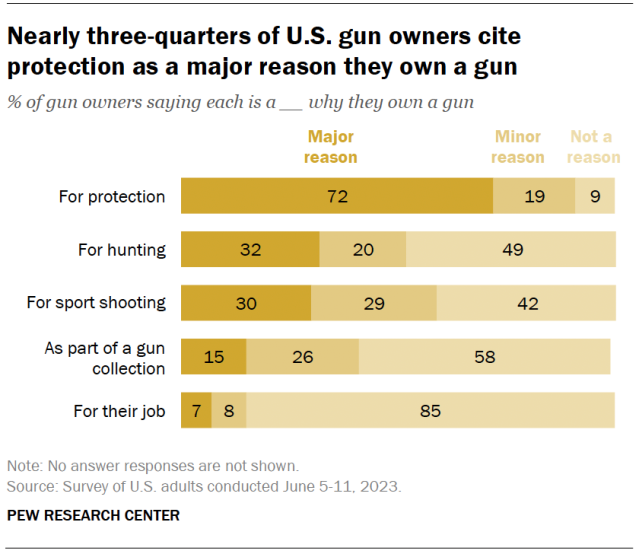
Gun owners tend to have much more positive feelings about having a gun in the house than non-owners who live with them. For instance, 71% of gun owners say they enjoy owning a gun – but far fewer non-gun owners in gun-owning households (31%) say they enjoy having one in the home. And while 81% of gun owners say owning a gun makes them feel safer, a narrower majority (57%) of non-owners in gun households say the same about having a firearm at home. Non-owners are also more likely than owners to worry about having a gun in the home (27% vs. 12%, respectively).
Feelings about gun ownership also differ by political affiliation, even among those who personally own firearms. Republican gun owners are more likely than Democratic owners to say owning a gun gives them feelings of safety and enjoyment, while Democratic owners are more likely to say they worry about having a gun in the home.
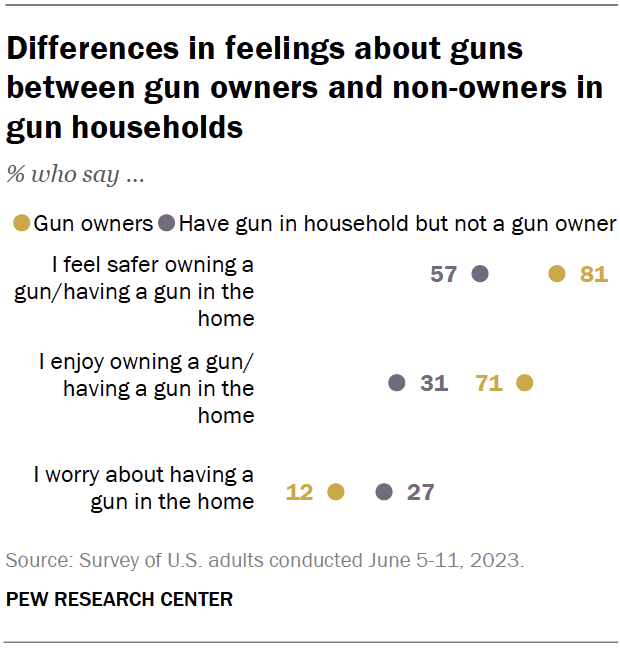
Non-gun owners are split on whether they see themselves owning a firearm in the future. About half (52%) of Americans who don’t own a gun say they could never see themselves owning one, while nearly as many (47%) could imagine themselves as gun owners in the future.
Among those who currently do not own a gun:
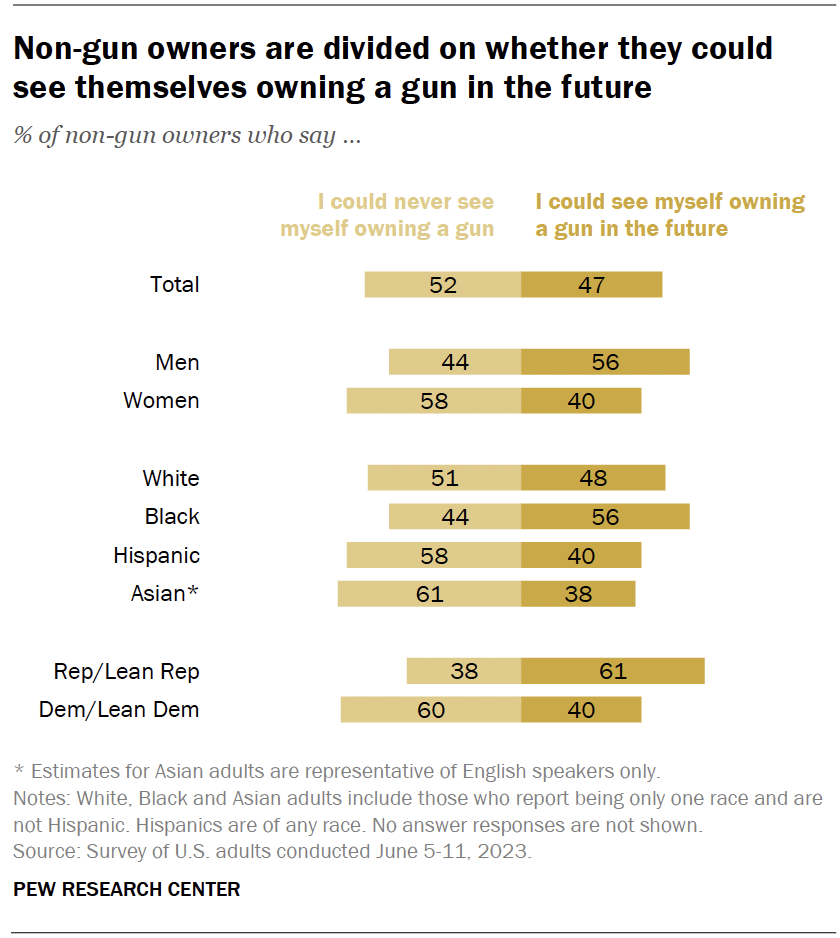
- 61% of Republicans and 40% of Democrats who don’t own a gun say they would consider owning one in the future.
- 56% of Black non-owners say they could see themselves owning a gun one day, compared with smaller shares of White (48%), Hispanic (40%) and Asian (38%) non-owners.
Americans are evenly split over whether gun ownership does more to increase or decrease safety. About half (49%) say it does more to increase safety by allowing law-abiding citizens to protect themselves, but an equal share say gun ownership does more to reduce safety by giving too many people access to firearms and increasing misuse.
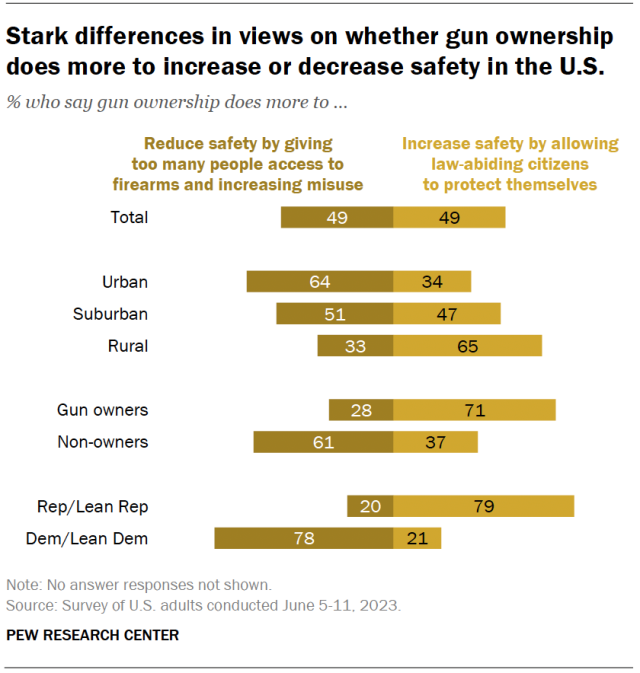
Republicans and Democrats differ on this question: 79% of Republicans say that gun ownership does more to increase safety, while a nearly identical share of Democrats (78%) say that it does more to reduce safety.
Urban and rural Americans also have starkly different views. Among adults who live in urban areas, 64% say gun ownership reduces safety, while 34% say it does more to increase safety. Among those who live in rural areas, 65% say gun ownership increases safety, compared with 33% who say it does more to reduce safety. Those living in the suburbs are about evenly split.
Americans increasingly say that gun violence is a major problem. Six-in-ten U.S. adults say gun violence is a very big problem in the country today, up 9 percentage points from spring 2022. In the survey conducted this June, 23% say gun violence is a moderately big problem, and about two-in-ten say it is either a small problem (13%) or not a problem at all (4%).
Looking ahead, 62% of Americans say they expect the level of gun violence to increase over the next five years. This is double the share who expect it to stay the same (31%). Just 7% expect the level of gun violence to decrease.
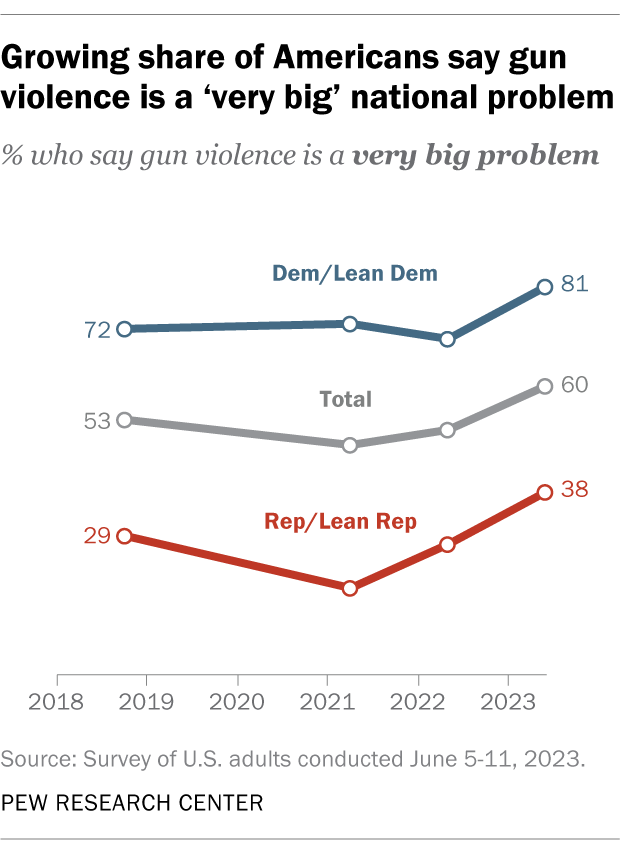
A majority of Americans (61%) say it is too easy to legally obtain a gun in this country. Another 30% say the ease of legally obtaining a gun is about right, and 9% say it is too hard to get a gun. Non-gun owners are nearly twice as likely as gun owners to say it is too easy to legally obtain a gun (73% vs. 38%). Meanwhile, gun owners are more than twice as likely as non-owners to say the ease of obtaining a gun is about right (48% vs. 20%).
Partisan and demographic differences also exist on this question. While 86% of Democrats say it is too easy to obtain a gun legally, 34% of Republicans say the same. Most urban (72%) and suburban (63%) dwellers say it’s too easy to legally obtain a gun. Rural residents are more divided: 47% say it is too easy, 41% say it is about right and 11% say it is too hard.
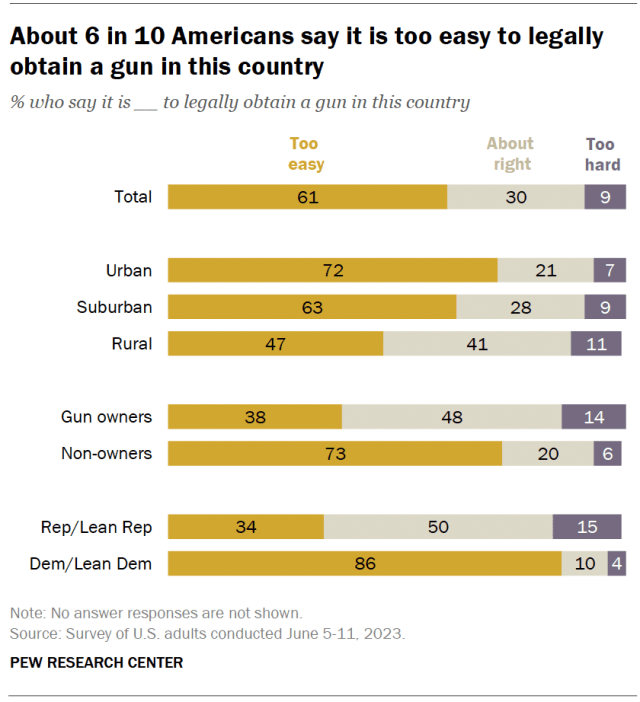
About six-in-ten U.S. adults (58%) favor stricter gun laws. Another 26% say that U.S. gun laws are about right, and 15% favor less strict gun laws. The percentage who say these laws should be stricter has fluctuated a bit in recent years. In 2021, 53% favored stricter gun laws, and in 2019, 60% said laws should be stricter.
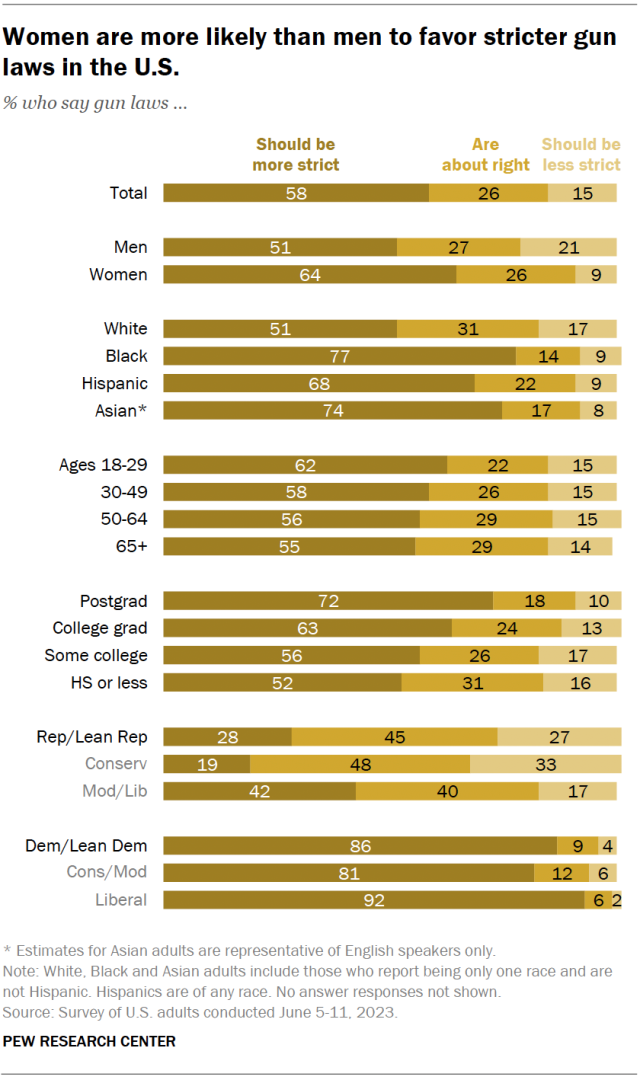
About a third (32%) of parents with K-12 students say they are very or extremely worried about a shooting ever happening at their children’s school, according to a fall 2022 Center survey of parents with at least one child younger than 18. A similar share of K-12 parents (31%) say they are not too or not at all worried about a shooting ever happening at their children’s school, while 37% of parents say they are somewhat worried.
Among all parents with children under 18, including those who are not in school, 63% see improving mental health screening and treatment as a very or extremely effective way to prevent school shootings. This is larger than the shares who say the same about having police officers or armed security in schools (49%), banning assault-style weapons (45%), or having metal detectors in schools (41%). Just 24% of parents say allowing teachers and school administrators to carry guns in school would be a very or extremely effective approach, while half say this would be not too or not at all effective.
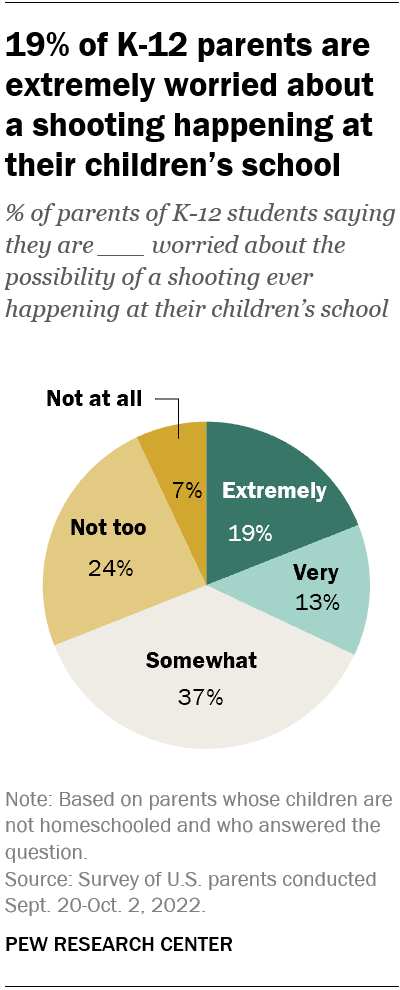
There is broad partisan agreement on some gun policy proposals, but most are politically divisive, the June 2023 survey found . Majorities of U.S. adults in both partisan coalitions somewhat or strongly favor two policies that would restrict gun access: preventing those with mental illnesses from purchasing guns (88% of Republicans and 89% of Democrats support this) and increasing the minimum age for buying guns to 21 years old (69% of Republicans, 90% of Democrats). Majorities in both parties also oppose allowing people to carry concealed firearms without a permit (60% of Republicans and 91% of Democrats oppose this).
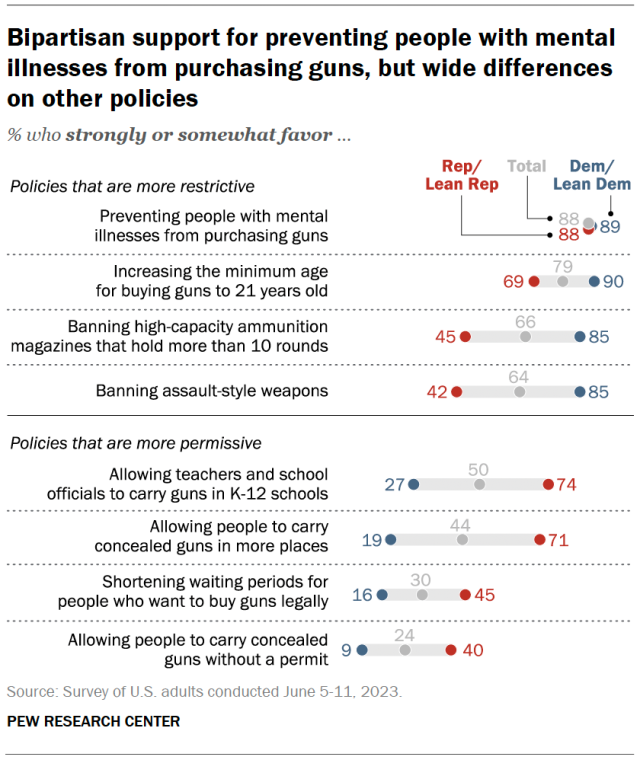
Republicans and Democrats differ on several other proposals. While 85% of Democrats favor banning both assault-style weapons and high-capacity ammunition magazines that hold more than 10 rounds, majorities of Republicans oppose these proposals (57% and 54%, respectively).
Most Republicans, on the other hand, support allowing teachers and school officials to carry guns in K-12 schools (74%) and allowing people to carry concealed guns in more places (71%). These proposals are supported by just 27% and 19% of Democrats, respectively.
Gun ownership is linked with views on gun policies. Americans who own guns are less likely than non-owners to favor restrictions on gun ownership, with a notable exception. Nearly identical majorities of gun owners (87%) and non-owners (89%) favor preventing mentally ill people from buying guns.
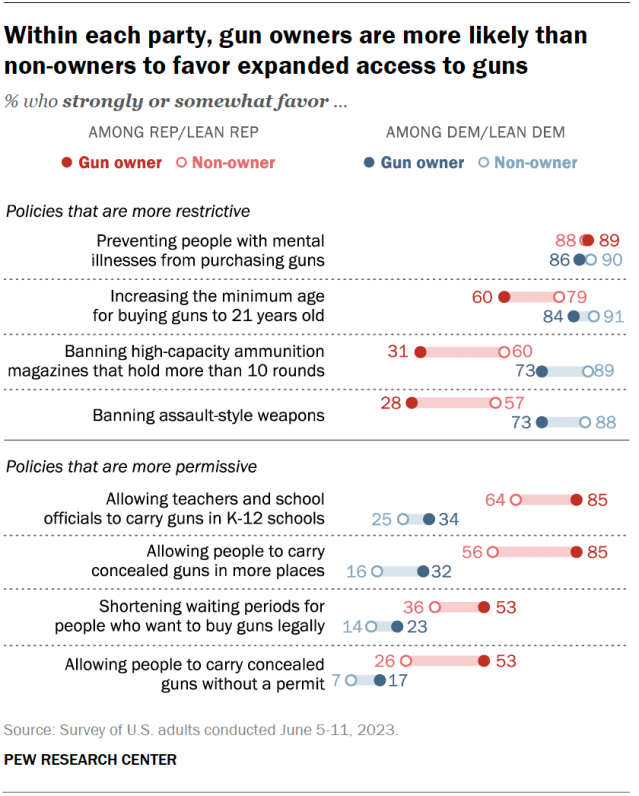
Within both parties, differences between gun owners and non-owners are evident – but they are especially stark among Republicans. For example, majorities of Republicans who do not own guns support banning high-capacity ammunition magazines and assault-style weapons, compared with about three-in-ten Republican gun owners.
Among Democrats, majorities of both gun owners and non-owners favor these two proposals, though support is greater among non-owners.
Note: This is an update of a post originally published on Jan. 5, 2016 .
- Partisanship & Issues
- Political Issues

Katherine Schaeffer is a research analyst at Pew Research Center
About 1 in 4 U.S. teachers say their school went into a gun-related lockdown in the last school year
Striking findings from 2023, for most u.s. gun owners, protection is the main reason they own a gun, gun violence widely viewed as a major – and growing – national problem, what the data says about gun deaths in the u.s., most popular.
1615 L St. NW, Suite 800 Washington, DC 20036 USA (+1) 202-419-4300 | Main (+1) 202-857-8562 | Fax (+1) 202-419-4372 | Media Inquiries
Research Topics
- Age & Generations
- Coronavirus (COVID-19)
- Economy & Work
- Family & Relationships
- Gender & LGBTQ
- Immigration & Migration
- International Affairs
- Internet & Technology
- Methodological Research
- News Habits & Media
- Non-U.S. Governments
- Other Topics
- Politics & Policy
- Race & Ethnicity
- Email Newsletters
ABOUT PEW RESEARCH CENTER Pew Research Center is a nonpartisan fact tank that informs the public about the issues, attitudes and trends shaping the world. It conducts public opinion polling, demographic research, media content analysis and other empirical social science research. Pew Research Center does not take policy positions. It is a subsidiary of The Pew Charitable Trusts .
Copyright 2024 Pew Research Center
Terms & Conditions
Privacy Policy
Cookie Settings
Reprints, Permissions & Use Policy
Thank you for visiting nature.com. You are using a browser version with limited support for CSS. To obtain the best experience, we recommend you use a more up to date browser (or turn off compatibility mode in Internet Explorer). In the meantime, to ensure continued support, we are displaying the site without styles and JavaScript.
- View all journals
- Explore content
- About the journal
- Publish with us
- Sign up for alerts
Latest science news, discoveries and analysis

China's Moon atlas is the most detailed ever made

‘Shut up and calculate’: how Einstein lost the battle to explain quantum reality

Rat neurons repair mouse brains — and restore sense of smell

Mini-colon and brain 'organoids' shed light on cancer and other diseases
Scientists urged to collect royalties from the ‘magic money tree’, first glowing animals lit up the oceans half a billion years ago, plastic pollution: three numbers that support a crackdown, the maldives is racing to create new land. why are so many people concerned, ecologists: don’t lose touch with the joy of fieldwork chris mantegna.

Should the Maldives be creating new land?

Lethal AI weapons are here: how can we control them?

Algorithm ranks peer reviewers by reputation — but critics warn of bias

How gliding marsupials got their ‘wings’
Nato is boosting ai and climate research as scientific diplomacy remains on ice, atomic clock keeps ultra-precise time aboard a rocking naval ship, who redefines airborne transmission: what does that mean for future pandemics, dna from ancient graves reveals the culture of a mysterious nomadic people.

Retractions are part of science, but misconduct isn’t — lessons from a superconductivity lab

Any plan to make smoking obsolete is the right step

Citizenship privilege harms science
European ruling linking climate change to human rights could be a game changer — here’s how charlotte e. blattner, will ai accelerate or delay the race to net-zero emissions, current issue.

Surprise hybrid origins of a butterfly species
Stripped-envelope supernova light curves argue for central engine activity, optical clocks at sea, research analysis.

Ancient DNA traces family lines and political shifts in the Avar empire

A chemical method for selective labelling of the key amino acid tryptophan

Robust optical clocks promise stable timing in a portable package

Targeting RNA opens therapeutic avenues for Timothy syndrome
Bioengineered ‘mini-colons’ shed light on cancer progression, galaxy found napping in the primordial universe, tumours form without genetic mutations, marsupial genomes reveal how a skin membrane for gliding evolved.

Breaking ice, and helicopter drops: winning photos of working scientists

Shrouded in secrecy: how science is harmed by the bullying and harassment rumour mill
How ground glass might save crops from drought on a caribbean island, londoners see what a scientist looks like up close in 50 photographs, books & culture.

How volcanoes shaped our planet — and why we need to be ready for the next big eruption

Dogwhistles, drilling and the roots of Western civilization: Books in brief

Cosmic rentals
Las boriqueñas remembers the forgotten puerto rican women who tested the first pill, dad always mows on summer saturday mornings, nature podcast.

Latest videos
Nature briefing.
An essential round-up of science news, opinion and analysis, delivered to your inbox every weekday.
Quick links
- Explore articles by subject
- Guide to authors
- Editorial policies

- [ April 23, 2024 ] Live coverage: Rocket Lab launches NASA, Korean payloads on Electron flight Electron
- [ April 23, 2024 ] SpaceX completes 300th Falcon booster landing during Starlink mission Falcon 9
- [ April 22, 2024 ] News from the Press Site: NASA explores new path for Mars Sample Return, Dragonfly mission to Titan gets green light News
- [ April 18, 2024 ] SpaceX completes 40th Falcon 9 launch of the year with Starlink mission Falcon 9
- [ April 17, 2024 ] SpaceX launches Falcon 9 rocket on Starlink mission from Kennedy Space Center Falcon 9
NASA requests proposals to reduce cost, timeline of Mars Sample Return mission
NASA is going back to square one when it comes to many aspects of its Mars Sample Return mission in response to independent reviews that showed ballooning costs and significant schedule delays.
The current architecture called for no less than five separate vehicles to transport back to Earth more than two dozen samples collected on the Martian surface by the Perseverance rover, which has been traveling the Red Planet since 2021 and is the first of those.
“Every indication that we’ve had from the independent review boards, plus the [Inspector General], that this thing could cost up to $11 billion, which would cause NASA to have to cannibalize other programs,” Nelson said, referring to science programs, like the Dragonfly mission to Saturn’s moon, Titan, and the Near-Earth Object (NEO) Surveyor mission to find and track potentially hazardous objects.
That cost estimate of $11 billion came from the second MSR Independent Review Board (IRB-2) analysis in which it estimated needing between $850 million and $1 billion annually during the development period. Nelson pointed out that the Decadal Survey, an assessment of priorities from the science community via the National Science Foundation created every ten years, argued that it should cost approximately between $5 and $7 billion.
He described the $11 billion projection as being “too expensive” and a 2040 sample return date as being “unacceptably too long.”
“It’s the decade of the 2040s that we’re going to be landing astronauts on Mars,” Nelson said.
“I have asked our folks to reach out with a request for information to industry, to [the Jet Propulsion Lab] and to all NASA centers and to report back this fall an alternate plan that would get it back quicker and cheaper and try to stay within those limits.”
A request for proposal will be published on April 16. That will be followed by an industry day on April 22 to field questions. Short proposals will be due on May 17 with a selection expected by Fall 2024.
Dr. Nicky Fox, the associate administrator of NASA’s Science Mission Directorate, also noted that the management structure of MSR would be changing as well. Instead of couching everything under JPL, it would instead move the different elements of the mission into standalone management.
“What we’re hoping is that we will be able to get back some more traditional, tried and true architectures, things that do not require huge technological leaps, but that have high heritage and thereby we can lower the risk and the cost and also the time for development,” Fox said. “Anything requiring huge leaps in technology, usually, from experience, takes a lot of time.”
Technological marvel with heritage products
The feat being carried out by the MSR is something never done before. It would require a lander, touching down on the surface of Mars, retrieving the samples collected by the Perseverance rover, sending them up to Martian orbit and then bringing them back to Earth.
The mission is being doing in partnership with the European Space Agency (ESA), which is assisting with the Earth Return Orbiter (ERO) along with the Capture Containment and Return System (CCRS).
In 2022, Lockheed Martin was selected as the prime contractor for three elements of MSR:
- $35 million – cruise stage of the lander
- $194 million – Mars Ascent Vehicle (MAV)
- $2.6 million – preliminary design of the Earth Entry System
Spaceflight Now reached out to see if those contracts are still in place and are waiting to hear back. The MSR IRB-2 Review Team (MIRT), which was formed to respond to the IRB-2 assessment, had a written recommendation was to launch the ERO/CCRS with ESA in 2030 and and to launch the Sample Retrieval Lander (SRL)/MAV in 2035.
During a teleconference with members of the press, Fox said that 2030 is a possible launch date for the ERO/CCRS, but that’s not a hard and fast date, noting it could change “when we see the results of the architecture studies.”
Fox said that proven technology with heritage is preferable for this new architecture as opposed to wholly new systems.
“If you have subsystems, you have pieces of architecture that’s been used before, then, that really does improve the risk posture and it removes any need to do a big technology development,” Fox said.
While a formal request for proposal won’t be published until Tuesday, in a social media post, SpaceX founder Elon Musk put forward the company’s Starship rocket, which aims to achieve full reusability over time.
Starship has the potential to return serious tonnage from Mars within ~5 years — Elon Musk (@elonmusk) April 15, 2024
Impacts and budget challenges
Nelson said the goal of reducing the cost of MSR is to prevent it from having knock on effects for other key NASA priorities, like planned missions to Venus and Jupiter. During his remarks to the press on Monday, he pointed to congressional budgetary restrictions as part of their challenge.
In response, NASA decided on a $310 million budget for MSR in FY2024 and requesting $200 million for the FY2025 budget. Nelson said he was in communication with members of Congress and would be speaking with the Senate Appropriations Committee, which governs NASA, on Wednesday.
“They seem to be quite understanding of the predicament that we’re in and I take it back to the old country boy saying, ‘You can’t put 10 pounds of potatoes in a five-pound sack,’” Nelson said. “And so, we are trying to take the budget that we have been constrained with, a $2.5 billion hit and a billion of that is just in science and we’re trying to figure out how to make this go forward without hurting Dragonfly and NEO Surveyor and DAVINCI and VERITAS , all of these that are so important to the future of our planetary science program.”
In statements released by lawmakers on Monday, there seemed to be quite a bit of consternation. Rep. Judy Chu (CA-28) said she was “disappointed that after eight long months of review on the Mars Sample Return mission, NASA is only just now issuing a call for studies on the best path forward.”
“I am extremely concerned that NASA is proposing a funding level for MSR that will be insufficient for JPL to continue making robust progress on the mission without sacrificing its integrity,” Chu said. “It frustrates me that NASA has chosen the Planetary Science Decadal Survey’s highest-priority mission to absorb almost the entire share of funding reductions.”
California’s two senators, Sen. Alex Padilla (D-CA) and Sen. Laphonza Butler (D-CA), issued a joint statement, reiterating their hope that NASA would allocate “the full $650 million necessary to fund the MSR mission in NASA’s FY24 spending plan” and urged Nelson to “better balance these cuts so that the JPL workforce is protected and the mission proceeds while NASA and JPL evaluate if additional industry solutions are necessary.”
“These cuts will delay the mission at a critical time, further diminish our highly-skilled workforce, and significantly undermine California’s Jet Propulsion Laboratory and our state’s globally-leading science and space leadership as we face increasing competition with China,” the senators said. “These funding levels are woefully short for a mission that NASA itself identified as its highest priority in planetary science and that has been decades in the making.”
Regarding how the budget cuts may impact staffing at JPL, which experienced a round of layoffs in recent months, Fox said in a virtual town hall on Monday that they are working on providing guidance, but don’t directly control staffing there.
“NASA does not give any guidance or have any involvement in their workforce choices, but we do provide programmatic guidance and budget numbers,” Fox said. “So we are working closely with them. We do not have an answer today. We’ve not done the work at the NASA centers to look at what, if any, workforce reductions they would need to take.”
© 1999-2024 Spaceflight Now Inc

IMAGES
VIDEO
COMMENTS
Template 1: Projected Research Timeline Milestone PPT PowerPoint Presentation Ideas Backgrounds. If you need to learn how to make a research document and set schedule activities for each step, then use this fantastic research template that encompasses the content of a well-maintained research paper. Organize your activities and map meetings ...
Research Project Timeline Example 1 Stage Activity Estimated duration Start date End date Deliverable Comments Research ... Draft research design section for final report Prepare research proposal Research proposal/ethical approval submission Literature review Search, capture and synthesise relevant literature Notes and other output from the ...
Confirm that your project is feasible within the timeline of your program or funding deadline. Research proposal length. The length of a research proposal can vary quite a bit. A bachelor's or master's thesis proposal can be just a few pages, while proposals for PhD dissertations or research funding are usually much longer and more detailed ...
A well-planned research proposal timeline is critical to the success of any project, ensuring that all tasks are completed on time and that the research stays on track. This article outlines a sample timeline for a research proposal, with key milestones and deadlines to help you stay organized and focused. 1.Identify research topic (Week 1)
Research Sample Timeline 1) Conduct continuous, thorough literature review to identify gaps in knowledge and experts in the field 2) Identify specific aims of project based on your research vision, plan, preliminary data results and literature review results 7) Begin drafting proposal budget to insure project goals can be met
Take a look at this sample research timeline. This sample timeline shows you how to break down tasks over time. Work backwards from the due date and create a timeline ; Target for what you want to accomplish and when; In a group project? Use the timeline to assign tasks to group members and agree on when specific parts will be done. Timeline ...
A thorough timeline will be valuable during your dissertation proposal and useful if you are applying for grants or other additional funding. Ste0ps for Creating a Timeline for Your Thesis: Research and record all requirements and deadlines. Before you write out your timeline, ensure you know all of your program's requirements and deadlines.
10. Physical Setting and Location. 11. Public Policy. Th e Center for Association Leadership partnered with a specialist in behavioral research who guided the development of both a process and a set of tools that included multiple data inputs, in multiple for-mats. We structured the process and the instruments together.
The purpose of the research proposal (its job, so to speak) is to convince your research supervisor, committee or university that your research is suitable (for the requirements of the degree program) and manageable (given the time and resource constraints you will face). The most important word here is "convince" - in other words, your ...
4)Choose a timeline design 5)Fill the timeline with the big tasks 6)Copy over timeline 1 and create timeline 2 with themedium tasks included maintain its format.Also use a key so it is easily understood. Tasks/deadlinesyou may include in timeline1: Coursework major deadlines Write research proposal Write literature review Planningmethods
1 Identify your main objectives. The first step to create a timeline for your research proposal is to identify your main objectives. These are the specific, measurable, and achievable goals that ...
There are many different ways to present a timeline; three good examples follow below. Remember that your proposal, timeline, and budget should work in concert to demonstrate the feasibility of your project. EXAMPLE #1. Total project hours - 350. Work week: Mon-Fri, 9am-5pm (35 hrs/week for 10 weeks).
Developing a proper timeline for your research proposal is essential for the process. Writing a research proposal might seem like a daunting and, at times, unending process. However, like any large project, breaking the task down into smaller, more manageable tasks makes the job easier and far less stressful. A ...
The timeline must comprise a series of objectives that should be met to complete all the aspects of your academic research requirements (thesis, dissertation, or other degree requisites), from preliminary research to the final editing. ... A quality example of a research proposal shows one's above-average analytical skills, including the ...
Research Proposal Example/Sample. Detailed Walkthrough + Free Proposal Template. If you're getting started crafting your research proposal and are looking for a few examples of research proposals, you've come to the right place. In this video, we walk you through two successful (approved) research proposals, one for a Master's-level ...
1. Research Proposal Format Example. Following is a general outline of the material that should be included in your project proposal. I. Title Page II. Introduction and Literature Review (Chapters 2 and 3) A. Identification of specific problem area (e.g., what is it, why it is important). B. Prevalence, scope of problem.
2. Estimate your time. 3. Choose your tools. Be the first to add your personal experience. 4. Review and adjust. Be the first to add your personal experience. A research proposal timeline is a ...
A dissertation timeline includes a series of milestones that leads up to the dissertation defense, revisions, and final submission of your dissertation. Constructing an outline of every step in the dissertation process, including rough estimates of how long each will take, will give you a realistic picture of where you are in the process at any ...
Proposal Timelines. Two kinds of time lines need to be considered in a proposal: Internal and External. INTERNAL TIME LINE. The Internal time line describes the schedule of events/activities that will be conducted if the project or program that the proposal is funded (presented as a "calendar" with "milestones"). This should be linked to the funding requested, which is presented in the ...
Example: planning year 1 of a 3-year PhD. Most PhD students start their first year with a rough idea, but not a well-worked out plan and timeline. Therefore, they usually begin with working on a more elaborate research proposal in the first months of their PhD. This is also the case for our example PhD student Maria.
Template 3: Ten-Day Timeline for Proposal Budget Preparation. Preparing proposal budgets can be intimidating. Our PPT template comes with a predesigned 10-day timeline that guides you through the entire proposal budget process, from setting up meetings to sending the draft proposal to your manager.
Research Proposal Examples. Research proposals often extend anywhere between 2,000 and 15,000 words in length. The following snippets are samples designed to briefly demonstrate what might be discussed in each section. ... - Provide an overview of the research timeline - Break down the study into stages with specific timeframes (e.g., data ...
See examples of Honors Contracts on the Honors College Canvas. Discuss this project with your professor to determine: Project title, project description, and details (page or presentation length, for example), and weekly timeline to completion. You will need to submit these pieces of information on the contract proposal form.
The following outline provides a high-level overview of the FTC's proposed final rule:. The final rule bans new noncompetes with all workers, including senior executives after the effective date.
The Pew Research Center survey conducted June 5-11, 2023, on the Center's American Trends Panel, asks about gun ownership using two separate questions to measure personal and household ownership. ... (74%) and allowing people to carry concealed guns in more places (71%). These proposals are supported by just 27% and 19% of Democrats ...
Find breaking science news and analysis from the world's leading research journal.
A request for proposal will be published on April 16. That will be followed by an industry day on April 22 to field questions. Short proposals will be due on May 17 with a selection expected by ...